#ethel's illness makes it's debut
Explore tagged Tumblr posts
Text
Pulitzer Family Fact Post (Katherine's Siblings Edition)
I'm finally doing it, after threeish years, I'm finally making posts about my acquired knowledge of the Pulitzer family. I'm starting with what I know about his kids because I think that's what people would find most interesting. I'd quite like to go on about Pulitzer's siblings and what people have managed to figure out about his childhood but I'll do that another day. It's been a while so I might forget stuff or get things slightly wrong but I'm doing my best to be accurate. Information is mostly from James McGrath Morris' book, 'Pulitzer: A life in Politics, Print and Power' and records I looked at on Ancestry (I got really weird about this).
Pulitzer and his wife, Kate Davis, had 7 children: Ralph, Lucille, Katherine, Joseph, Edith, Constance and Herbert. I'm just going to go through kid-by-kid and reel off everything I remember that is actually semi-interesting.
Ralph Pulitzer: Born June 11th, 1879. Died June 14th, 1939. He was born in St. Louis because Pulitzer hadn't bought The New York World and moved the family to New York at this point.
All the kids seem to have been sickly (like their father) but Ralph was asthmatic and small for his age, his health was always a concern. The family would spend a lot of time in Europe but he and Lucille were the ones who usually joined their parents while the younger ones were left in America. He didn't like learning Latin (From a letter to Lucille: "I never imagined a language capable of such filthy, beastly rules and contradictions") and preferred Greek. He was educated at St. Mark's School and would've been at Harvard by the time that Newsies happened.
All the sons were a bit detached from the realities of how newspapers worked because they were raised in mansions and boarding schools but Pulitzer was surprised and very upset about them having limited journalistic skills. He really wanted them to be prepared to run the paper after him and they really weren't. He started to become president of The World around 1907. When Pulitzer died, he got 20% of the newspaper stock in the will. He was the main person running The World before they sold it in 1931. Ralph preferred high society life to newspapers. He married Frederica Webb who was vaguely a Vanderbilt in 1905. They had two sons, I think, and eventually divorced. He remarried and had two daughters but one died very young. He died in New York following complications to do with abdominal surgery.
Lucille Irma Pulitzer: Born September 30th, 1880. Died December 31st, 1897. She was probably also born in St. Louis but I haven't been able to find the record. Her middle name seems to come from one of Pulitzer's sisters.
She was Pulitzer's favourite, that's the key thing about her. He had very high expectations of his children and a lot of rules, and she managed to meet those expectations and didn't break those rules. She was focused on her studies, she could speak multiple languages and play multiple instruments. In Pulitzer's code-book, she's referred to as 'Lulu' instead of Lucille. Seems to have spent a lot of her younger years in Europe. When she was 14 she had a minor throat surgery and Pulitzer got upset that everyone was paying her more attention than they were him (his wife got really mad at him and he sent Lucille flowers to apologise).
I think I read about her graduating from Miss Brown's School for Young Ladies in May 1897 when she would've been 16. Summer of that year they held a party at the Chatwold (their place in Bar Harbour) to basically debut her. A couple days later, she became ill. She had Typhoid and despite the family's efforts, she died months later at the Chatwold on New Years Eve. After her death, Pulitzer established the Lucille Pulitzer Scholarship at Barnard College, which makes me think she wanted to go to college and that he would have supported this.
Katherine Ethel Pulitzer: Born January 30th, 1882. Died May 9th, 1884. Same as Lucille, probably born in St. Louis but I've never seen the records. She's the one daughter whose middle name I can't link to one of Pulitzer's family members but her first name comes from her mother. There's not much to say because she died so young. She died of Pneumonia in New York almost a year exactly (one day off) after Pulitzer purchased The World.
This is quite sad (it's already sad) but she is either omitted or forgotten in the 1900 census. They asked for the number of children born and the number of children living, at this point all 7 had been born and 5 were alive but the Pulitzers responded that 6 had been born instead. They weren't forgetting Lucille after three years, so it seems like Katherine was not counted.
Joseph Pulitzer II: Born March 21st, 1885. Died March 30th, 1955. One of the few children born in New York.
Less sickly than the others but Pulitzer was constantly disappointed by him. He was also sent to St. Mark's School. As a teenager he didn't do what his father told him to and didn't pay enough attention to his studies. He got thrown out of St. Mark's in 1901 after he and some friends snuck out to buy beer and then ended up climbing into the headmaster and his wife's bedroom when they were sneaking back in. Pulitzer was really angry about that. Pulitzer managed to get him into Harvard but he just kept being the same as he was before so Pulitzer pulled him out of Harvard.
He got sent to St. Louis to be trained by the people Pulitzer had at the Post-Dispatch and actually developed journalistic talent. His father could not see this talent and was still disappointed in him. He only got 10% of the newspaper stock when his dad died. He ran the Post-Dispatch far better than his brothers ran The World. He tried to punch Hearst which is just really funny to me. He married Elinor Wickham in 1910, she died in 1925 and a year later he married Elizabeth Edgar. He had similar health problems to his father towards the end of his life and after he died, the Post-Dispatch passed to his son, Joseph Pulitzer III, it stayed in the family's hands until very recently (either the 90s or the 00s) but there was a legal battle about whether to sell it in the 80s.
Edith Louise Pulitzer: Born June 19th, 1886. Died April 6th, 1975. She was born in Lenox, Massachusetts. Her middle name seems to come from Pulitzer's mother.
Pulitzer was not that interested in his younger daughters but he still had high expectations for them. When she was younger and her parents travelled to Europe, she seems to have been left in America more than her older siblings but later on she seems to have been just following her mother around to wherever she went. She was 13 when the Pulitzer house fire happened in January 1900. Morris mentions an incident where she got upset at her father for constantly criticising her and the two of them had a bit of an argument. She was sent to Miss Vinton’s School for Girls in Connecticut.
She married William Scoville Moore a couple weeks after her father died, I think I read that they had to have a pretty boring, scaled back wedding because, officially, she and her mother were still in mourning. They had five sons. William died in 1944 and then two of their sons died in 1944 and 1945 fighting in the war. Another son died in 1957. She lived the longest out of all of the children, and 1975 feels so strangely recent for a child of Joseph Pulitzer to have been alive then. She and Constance both got the same amount in the will and it was obviously a lot of stuff but I think she might've tried to claim that it wasn't enough and that her father wasn't in his right mind when he made the will.
Constance Helen Pulitzer: Born December 13th, 1888. Died July 14th, 1938. She was born in France, probably Paris, because the family (Joseph, his wife and the eldest two children) were in Europe looking for advice on his worsening health when she was born. According to census responses from the early 20th century, her first language was French while all her siblings' had been English. Her middle name seems to come from another one of Pulitzer's sisters.
Pulitzer did not see her for very extended periods of time in her early childhood. She was also at home when the Pulitzer house fire happened, she was 11 at the time. Once, when Pulitzer was away from home, he only received a letter from Constance and told his wife to tell the other children he didn't love them (that's a quote, "To all the rest of the children you can say I do not love them"). She also followed her mother around Europe a bit when she got older. She debuted in 1907.
In 1913 she married William Grey Elmslie who had been her younger brother's tutor. The family expressed their support for the marriage but I think only Edith was actually present. Oh, this is Newsies relevant: she and Edith shared a property in Santa Fe. She died at 49 which is young even by Pulitzer family standards and makes her the first child to die in adulthood but I can't find a cause of death so I don't know what went on there.
Herbert Pulitzer: Born November 20th, 1896. Died September 4th, 1957. He was born in New York. I see him get called Tony a lot, he might've had a middle name that gets forgotten.
This is a twist you're not expecting: he may have not actually been Pulitzer's son. There's (significant) evidence that Kate was having an affair with Arthur Brisbane when she got pregnant with Herbert and it's definitely possible that Arthur was Herbert's father. He was born a long time after Constance considering that the first 6 children were born within 10 years of each other. And if you look at pictures of Pulitzer and his older sons at around the same age, they look very similar - I don't think Herbert looked that much like him but he does kinda look like Arthur. We can't really know but I do think it's very, very possible. Pulitzer never doubted that Herbert was his, and he seems to have been the favourite of his sons since he got 60% of the newspaper stock. He briefly ran The World in the years before it was sold but apparently people who worked there didn't like him. He was very young when the Pulitzer house fire happened and Kate had to go back inside to save him.
I'm less certain about details in Herbert's life than the other children, I'm not sure why I know less about him but I do. He was the only child at his father's deathbed, when he was only a teenager. He learnt to fly and fought at the end of WW1. Married Gladys Munn in 1926 and they had two children together. Their son, also called Herbert, led a messy life (highly publicised divorce). Herbert died of uremic poisoning, which is described "urine in the blood" and, yeah, that's the note this post is going out on.
Again, it's possible I've made mistakes or forgotten stuff here. I also can't stress enough how much information James McGrath Morris' book has provided this post.
#while factchecking this post i found a new funfact#pulitzer sent ralph for an examination at a hospital in my home city (birmingam uk) thats so cool for me and no one else#katherine plumber pulitzer my beloved#katherine plumber#katherine pulitzer#joseph pulitzer#newsies#mercury posting
13 notes
·
View notes
Text
The Bellows Book - Ethel’s Resignation (Sneak Peek)
I’m so excited to share this one with you all! It’s been in my drafts for months and I finally got around to polishing it up tonight. Obviously it will be much longer than this once it’s fully finished, but here’s a nice teaser for the full chapter. This contains MANY illusions to other parts of The Bellows Book, so don’t be alarmed if some references make no sense at this point. I promise that everything will fall into place once I can get more content ready for publishing. Time has just been a huge problem now, especially because my college classes have recently gotten very intense and I spend almost all of my time writing academic papers these days.
Content Below The Cut
Ephraim was being a coward, and he knew it. Rather than facing Ethel like he knew he ought to, he was hiding away in his room like a scared child. His father and brother were both at work at the mill, and Delanie was off making social calls with Gertrude. Surprisingly, his grandmother could be quite social when she wanted to be.
Sliding his feet off of his bed, he moved to his window once more, just in time to spot Ethel doubled over in some sort of fit. He opened the window slightly and was greeted with the sounds of a hacking cough, followed by a clearing of the throat. As Ethel began her walk down the driveway, he noticed that even her footsteps appeared weak. She plodded along slowly through the snow, nearly tripping a handful of times.
Ephraim wanted to help her. He wanted to rush out of the mansion and take her by the arm and help her home. He didn’t care that it would involve seeing Ruth again, or that it would certainly damage his reputation beyond repair when the world discovered what Ethel had learned. Why she hadn’t told them yet, he didn’t know.
He watched as she reached the end of the path, and then slowly made the turn onto the road back towards town. Another thought of concern flashed through his mind before he pushed it aside.
No! He thought. She’s tainted. She carries it - that curse - in her blood!
He turned around, his back pressed against the velvet of the curtains. He thought of Ethel, and of everything that could have been, of what might have happened if he hadn’t-
NO!
No! No! No!
Sometimes he feels as though he ought to beat himself in the head to push away his thoughts. This is one of those times.
He stood there for a while longer, listening to the ticking of the clock and the chirping of the few birds who braved the snow.
They reminded him of her, braving the snow in an attempt to bring something good to the bleak of winter.
He wanted to beat the thoughts away again.
Finally, once he was fully satisfied that Ethel was gone, he moved downstairs to retrieve the package she had left. Placing it on the foyer table, he carefully opened it. First there was a gingham tea towel, followed by a small batch of sweets and a few canned goods. At the bottom of the basket lay an envelope full of patient files, and a note in Ethel’s writing. Abandoning the basket and the food, Ephraim ascended the stairs with papers in hand.
As he reached the top of the stairs, he glanced back towards the kitchen, towards Sarah’s room. No, he thought. Now is not the time to dwell on old sins.
Slipping back into his bedroom, he slowly closed the door behind himself and moved towards his desk. He placed the files unceremoniously atop a pile of medical books and began to read Ethel’s letter.
To Whom It May Concern,
Regarding my employment at Pennhurst State Hospital —
Resignation.
Ephraim wanted to scream, to throw something, to reach for his belt to have a go at Sarah-
No!
No, that’s what started all of this to begin with!
Shut up!
No!
You murdered her!
It’s your fault that Ethel hates you!
She would have loved you, and you ruined it!
She couldn’t have loved me.
Ephraim was ripped away from his thoughts by the sound of the front door slamming open. Judging by the sound of heavy shuffling, the family had arrived home. He scrambled to hide Ethel’s letter, finally deciding on shoving it under his pillow.
He straightened his tie, smoothed his jacket, and was just about to step out onto the landing when Gertrude brushed past him, her pearls clicking together as she walked.
“Well, don’t you look disgusting!”
“Grandmother, I-”
She waved her hand in dismissal, the other still firmly grasping her cane.
“I may not be able to see it, but I can smell it. You’re having trouble with that little girl from the hospital, and it’s obvious that you can’t control the situation on your own! You’re the talk of the town because of her, and if it doesn’t get settled soon, I’ll have to-”
“She’s resigning, Grandmother. She handed in her letter today.”
Gertrude’s face instantly softened.
“Oh, well that’s good. Very good. More scandal is the last thing we need in this family.”
She leaned in closer, her milky eyes staring directly into Ephraim’s.
“You know that better than anyone.”
Ephraim nodded, although she couldn’t see. Satisfied, she continued down the hallway, her dog following close behind her.
#the bellows book#ethel moore#ephraim bellows#gertrude bellows#sarah bellows#deodat bellows#delanie bellows#harold bellows#ethel's illness makes it's debut
6 notes
·
View notes
Text
A retrospective on some of Broadway’s most important female costume designers across the last century
How much is our memory or perception of a production influenced by the manner in which we visually comprehend the characters for their physical appearance and attire? A lot.
How much attention in memory is often dedicated to celebrating the costume designers who create the visual forms we remember? Comparatively, not much.
Delving through the New York Public Library archives of late, I found I was able to zoom into pictures of productions like Sunday in the Park with George at a magnitude greater than before.
In doing so, I noticed myself marvelling at finer details on the costumes that simply aren’t visible from grainy 1985 proshots, or other lower resolution images.
And marvel I did.

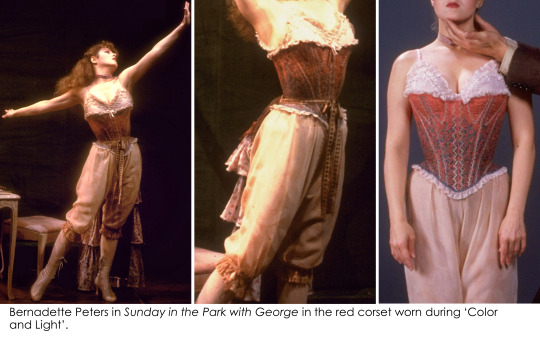
At first, I began to set out to address the contributions made to the show by designer Patricia Zipprodt in collaboration with Ann Hould-Ward. Quickly I fell into a (rather substantial) tangent rabbit hole – concerning over a century’s worth of interconnected designers who are responsible for hundreds of some of the most memorable Broadway shows between them.
It is impossible to look at the work of just one or two of these women without also discussing the others that came before them or were inspired by them.
Journey with me then if you will on this retrospective endeavour to explore the work and legacy that some of these designers have created, and some of the contexts in which they did so.
A set of podcasts featuring Ann Hould-Ward, including Behind the Curtain (Ep. 229) and Broadway Nation (Eps. 17 and 18), invaluably introduce some of the information discussed here and, most crucially, provide a first-hand, verbal link back to this history. The latter show sets out the case for a “succession of dynamic women that goes back to the earliest days of the Broadway musical and continues right up to today”, all of whom “were mentored by one or more of the great [designers] before them, [all] became Tony award-winning [stars] in their own right, and [all] have passed on the [craft] to the next generation.”
A chronological, linear descendancy links these designers across multiple centuries, starting in 1880 with Aline Bernstein, then moving to Irene Sharaff, then to Patricia Zipprodt, then to the present day with Ann Hould-Ward. Other designers branch from or interact with this linear chronology in different ways, such as Florence Klotz and Ann Roth – who, like Patricia Zipprodt, were also mentored by Aline Bernstein – or Theoni V. Aldredge, who stands apart from this connected tree, but whose career closely parallels the chronology of its central portion. There were, of course, many other designers and women also working within this era that provided even further momentous contributions to the world of costume design, but in this piece, the focus will remain primarily on these seven figures.

As the main creditor of the designs for Sunday in the Park with George, let’s start with Patricia (Pat) Zipprodt.
Born in 1925, Pat studied at the Fashion Institute of Technology (FIT) in New York after winning a scholarship there in 1951. Through teaching herself “all of costume history by studying materials at the New York Public Library”, she passed her entrance exam to the United Scenic Artists Union in 1954. This itself was a feat only possible through Aline Bernstein’s pioneering steps in demanding and starting female acceptance into this same union for the first time just under 30 years previously.
Pat made her individual costume design debut a year after assisting Irene Sharaff on Happy Hunting in 1956 – Ethel Merman’s last new Broadway credit. Of the more than 50 shows she subsequently designed, some of Pat’s most significant musicals include: She Loves Me (1963) Fiddler on the Roof (1964) Cabaret (1966) Zorba (1968) 1776 (1969) Pippin (1972) Mack & Mabel (1974) Chicago (1975) Alice in Wonderland (1983) Sunday in the Park with George (1984) Sweet Charity (1986) Into the Woods (1987) - preliminary work
Other notable play credits included: The Little Foxes (1967) The Glass Menagerie (1983) Cat on a Hot Tin Roof (1990)

Yes. One person designed all of those shows. Many of the most beloved pieces in modern musical theatre history. Somewhat baffling.
Her work notably earned her 11 Tony nominations, 3 wins, an induction into the Theatre Hall of Fame in 1992, and the Irene Sharaff award for lifetime achievement in costume design in 1997.
By 1983, Pat was one of the most well-respected designers of her era. When the offer for Sunday in the Park with George came in, she was less than enamoured by being confined to the ill-suited basements at Playwright’s Horizons all day, designing full costumes for a story not even yet in existence. From-the-ground-up workshops are common now, but at the time, Sunday was one of the first of its kind.
Rather than flatly declining, she asked Ann Hould-Ward, previously her assistant and intern who had now been designing for 2-3 years on her own, if she was interested in collaborating. She was. The two divided the designing between them, like Pat creating Bernadette’s opening pink and white dress, and Ann her final red and purple dress.

Which indeed leads to the question of the infamous creation worn in the opening number. No attemptedly comprehensive look at the costumes in Sunday would be complete without addressing it or its masterful mechanics.
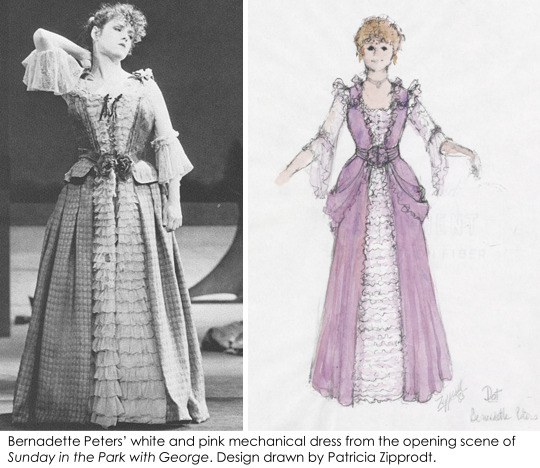
To enable Bernadette to spring miraculously and seemingly effortlessly from her outer confines, Ann and Pat enlisted the help of a man with a “Theatre Magics” company in Ohio. Dubbed ‘The Iron Dress’, the gasp-inducing motion required a wire frame embedded into the material, entities called ‘moonwalker legs and feet’, and two garage door openers coming up through the stage to lever the two halves apart. The mechanism – highly impressive in its periods of functionality – wasn’t without its flaws. Ann recalls “there were nights during previews where [Bernadette] couldn’t get out of the dress”. Or worse, a night where “the dress closed up completely. And it wouldn’t open up again!”. As Bernadette finished her number, there was nothing else within her power she could do, so she simply “grabbed it under her arm and carried it off stage.”
What visuals. Evidently, the course of costume design is not always plain sailing.
This sentiment is exhibited in the fact design work is a physical materialisation of other creators’ visions, thus foregrounding the tricky need for collaboration and compromise. This is at once a skill, very much part of the job description, and not always pleasant – in navigating any divides between one’s own ideas and those of other people.
Sunday in the Park with George was no exception in requiring such a moment of compromise and revision. With the show already on Broadway in previews, Stephen Sondheim decreed the little girl Louise’s dress “needs to be white” – not the “turquoisey blue” undertone Pat and Ann had already created it with. White, to better spotlight the painting’s centre.
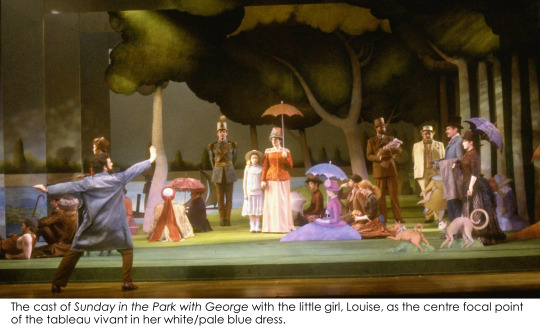
Requests for alterations are easier to comprehend when they are done with equanimity and have justification. Sondheim said he would pay for the new dress himself, and in Seurat’s original painting, the little girl is very brightly the focal centre point of the piece. On this occasion, all agreed that Sondheim was “absolutely right”. A new dress was made.
Other artistic differences aren’t always as amicable.
In Pat Zipprodt’s first show, Happy Hunting with Ethel Merman in 1956, some creatives and directors were getting in vociferous, progress-stopping arguments over a dress and a scene in which Ethel was to jump over a fence. Then magically, the dress went missing. Pat was working at the time as an assistant to the senior Irene Sharaff, and Pat herself was the one to find the dress the next morning. It was in the basement. Covered in black and wholly unwearable. Sharaff had spray painted the dress black in protest against the “bickering”. Indeed, Sharaff disappeared, not to be seen again until the show arrived on Broadway.
Those that worked with her soon found that Sharaff was one to be listened to and respected – as Hal Prince did during West Side Story. After the show opened in 1957, Hal replaced her 40 pairs of meticulously created and individually dyed, battered, and re-dyed jeans with off-the-rack copies. His reasoning was this: “How foolish to be wasting money when we can make a promotional arrangement with Levi Strauss to supply blue jeans free for program credit?” A year later, he looked at their show, and wondered “What’s happened?”
What had happened was that the production had lost its spark and noticeable portions of its beauty, vibrancy, and subtle individuality. Sharaff’s unique creations quickly returned, and Hal had learned his lesson. By the time Sharaff’s mentee, Pat, had “designed the most expensive rags for the company to wear” with this same idiosyncratic dyeing process for Fiddler on the Roof in 1964, Hal recognised the value of this particularity and the disproportionately large payoff even ostensibly simple garments can bring.
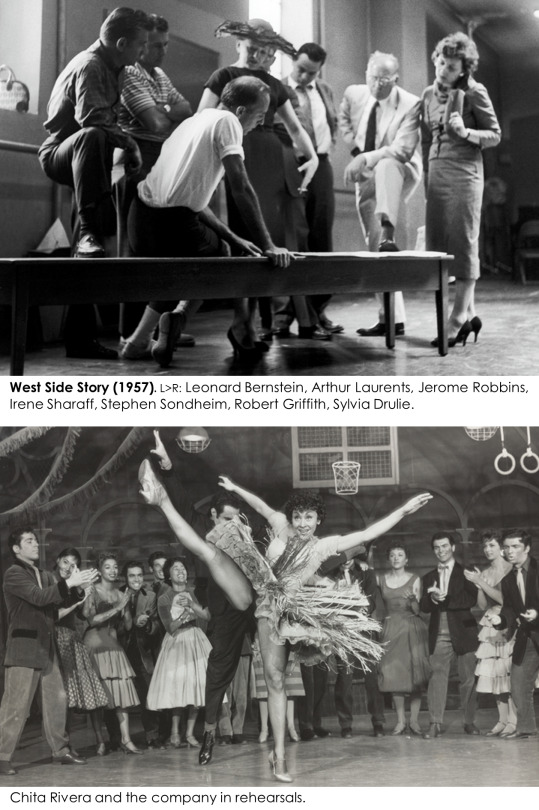
Irene Sharaff is remembered as one of the greatest designers ever. Born in 1910, she was mentored by Aline Bernstein, first assisting her on 1928’s original staging of Hedda Gabler.
Throughout her 56 year career, she designed more than 52 Broadway musicals. Some particularly memorable entities include: The Boys from Syracuse (1938) Lady in the Dark (1943) Candide (1956) Happy Hunting (1956) Sweet Charity (1966) The King and I (1951, 1956) West Side Story (1957, 1961) Funny Girl (1964, 1968)
For the last three productions, she would reprise her work on Broadway in the subsequent and indelibly enduring film adaptations of the same shows.
Her work in the theatre earned her 6 Tony nominations and 1 win, though her work in Hollywood was perhaps even more well rewarded – earning 5 Academy Awards from a total of 15 nominations.
Some of Sharaff’s additional film credits included: Meet Me in St. Louis (1944) Ziegfeld Follies (1946) An American in Paris (1951) Call Me Madam (1953) A Star is Born (1954) – partial Guys and Dolls (1955) Cleopatra (1963) Who’s Afraid of Virginia Woolf? (1966) Hello Dolly! (1969) Mommie Dearest (1981)
It’s a remarkable list. But it is too more than just a list.
Famously, Judy’s red scarlet ballgown in Meet Me in St. Louis was termed the “most sophisticated costume [she’d] yet worn on the screen.”
It has been written that Sharaff’s “last film was probably the only bad one on which she worked,” – the infamous pillar of camp culture, Mommie Dearest, in 1981 – “but its perpetrators knew that to recreate the Hollywood of Joan Crawford, it required an artist who understood the particular glamour of the Crawford era.” And at the time, there were very few – if any – who could fill that requirement better than Irene Sharaff.
The 1963 production of Cleopatra is perhaps an even more infamous endeavour. Notoriously fraught with problems, the film was at that point the most expensive ever made. It nearly bankrupted 20th Century Fox, in light of varying issues like long production delays, a revolving carousel of directors, the beginning of the infamous Burton/Taylor affair and resulting media storm, and bouts of Elizabeth’s ill-health that “nearly killed her”. In that turbulent environment, Sharaff is highlighted as one of the figures instrumental in the film’s eventual completion – “adjusting Elizabeth Taylor’s costumes when her weight fluctuated overnight” so the world finally received the visual spectacle they were all ardently anticipating.

But even beyond that, Sharaff’s work had impacts more significantly and extensively than the immediate products of the shows or films themselves. Within a few years of her “vibrant Thai silk costumes for ‘The King and I’ in 1951, …silk became Thailand’s best-known export.” Her designs changed the entire economic landscape of the country.
It’s little wonder that in that era, Sharaff was known as “one of the most sought-after and highest-paid people in her profession.” With discussions and favourable comparisions alongside none other than Old Hollywood’s most beloved designer, Edith Head, Irene deserves her place in history to be recognised as one of the foremost significant pillars of the design world.
In this respected position, Irene Sharaff was able to pass on her knowledge by mentoring others too as well as Patricia Zipprodt, like Ann Roth and Florence Klotz, who have in turn gone on to further have their own highly commendable successes in the industry.
Florence “Flossie” Klotz, born in 1920, is the only Broadway costume designer to have won six Tony awards. She did so, all of them for musicals, and all of them directed by Hal Prince, in a marker of their long and meaningful collaboration.
Indeed, Flossie’s life partner was Ruth Mitchell – Hal’s long-time assistant, and herself legendary stage manager, associate director and producer of over 43 shows. Together, Flossie and Ruth were dubbed a “power couple of Broadway”.
Flossie’s shows with Hal included: Follies (1971) A Little Night Music (1973) Pacific Overtures (1976) Grind (1985) Kiss of the Spiderwoman (1993) Show Boat (1995)
And additional shows amongst her credits extend to: Side by Side by Sondheim (1977) On the Twentieth Century (1978) The Little Foxes (1981) A Doll’s Life (1982) Jerry’s Girls (1985)
Earlier in her career, she would first find her footing as an assistant designer on some of the Golden Age’s most pivotal shows like: The King and I (1951) Pal Joey (1952) Silk Stockings (1955) Carousel (1957) The Sound of Music (1959)
The original production of Follies marked the first time Florence was seriously recognised for her work. Before this point, she was not yet anywhere close to being considered as having broken into the ranks of Broadway’s “reigning designers” of that era. Follies changed matters, providing both an indication of the talent of her work to come, and creating history in being commended for producing some of the “best costumes to be seen on Broadway” in recent memory – as Clive Barnes wrote in The New York Times. Fuller discussion is merited given that the costumes of Follies are always one of the show’s central points of debate and have been crucial to the reception of the original production as well as every single revival that has followed in the 50 years since.

In this instance, Ted Chapin would record from his book ‘Everything Was Possible: The Birth of the Musical ‘Follies’ how “the costumes were so opulent, they put the show over-budget.” Moreover, that “talking about the show years later, [Florence] said the costumes could not be made today. ‘Not only would they cost upwards of $2 million, but we used fabrics from England that aren’t even made anymore.’” Broadway then does indeed no longer look like Broadway now.
This “surreal tableau” Flossie created, including “three-foot-high ostrich feather headdresses, Marie Antoinette wigs adorned with musical instruments and birdcages, and gowns embellished with translucent butterfly wings”, remains arguably one of the most impressive and jaw-dropping spectacles to have ever graced a Broadway stage even to this day.
As for Ann Roth, born in 1931, she is still to this day making her own history – recently becoming the joint eldest nominee at 89 for an Oscar (her 5th), for her work on 2020′s Ma Rainey’s Black Bottom. Now as of April 26th, Ann has just made history even further by becoming the oldest woman to win a competitive Academy Award ever. She has an impressive array of Hollywood credits to her name in addition to a roster of Broadway design projects, which have earned her 12 Tony nominations.
Some of her work in the theatre includes: The Women (1973) The Best Little Whorehouse in Texas (1978) They're Playing Our Song (1979) Singin' in the Rain (1985) Present Laughter (1996) Hedda Gabler (2009) A Raisin in the Sun (2014) Shuffle Along (2016) The Prom (2018)
Making her way over to Hollywood in the ‘70s, she has left an indelible and lasting visual impact on the arts through films like: Klute (1971) The Goodbye Girl (1977) Hair (1979) 9 to 5 (1980) Silkwood (1983) Postcards from the Edge (1990) The Birdcage (1996) The Hours (2002) Mamma Mia! (2008) Ma Rainey’s Black Bottom (2020)

It’s clear from this branching 'tree' to see how far the impact of just one woman passing on her time and knowledge to others who are starting out can spread.
This art of acting as a conduit for valuable insights was something Irene Sharaff had learned from her own mentor and predecessor, Aline Bernstein. Aline was viewed as “the first woman in the [US] to gain prominence in the male-dominated field of set and costume design,” and was too a strong proponent of passing on the unique knowledge she had acquired as a pioneer and forerunner in the field.
Born in 1880, Bernstein is recognised as “one of the first theatrical designers in New York to make sets and costumes entirely from scratch and craft moving sets” while Broadway was still very much in its infancy of taking shape as the world we know today. This she did for more than one hundred shows over decades of her work in the theatre. These shows included the spectacular Grand Street Follies (1924-27), and original premier productions of plays like some of the following: Ibsen’s Hedda Gabler (1928) J.M Barrie’s Peter Pan (1928) Grand Hotel (1930) Phillip Barry’s Animal Kingdom (1932) Chekov’s The Seagull (1937) Both Lillian Hellman’s The Children’s Hour (1934) and The Little Foxes (1939)
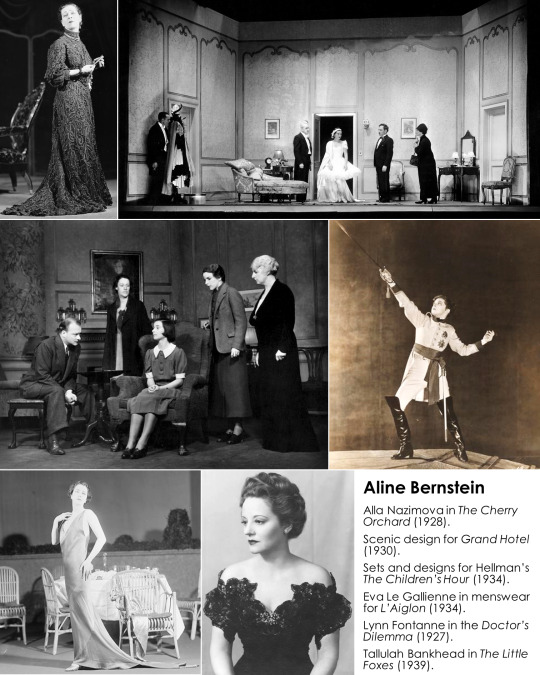
Beyond direct design work, Bernstein founded what was to become the Neighbourhood Playhouse (the notable New York acting school) and was influential in the “Little Theatre movement that sprung up across America in 1910”. These were the “forerunners of the non-profit theatres we see today” and she continued to work in this realm even after moving into commercial theatre.
Bernstein also established the Museum of Costume Art, which later became the Costume Institute of the Met Museum of Art, where she served as president from 1944 to her death in 1955. This is what the Met Gala raises money for every year. So for long as you have the world’s biggest celebrities parading up and down red carpets in high fashion pieces, you have Aline Bernstein to remember – as none of that would be happening without her.
During the last fifteen years of her life, Bernstein taught and served as a consultant in theatre programs at academic institutions including Yale, Harvard, and Vassar – keen to connect the community and facilitate an exchange of wisdom and information to new descendants and the next generation.
Many designers came somewhere out of this linear descendancy. One notable exception, with no American mentor, was Theoni V. Aldredge. Born in 1922 and trained in Greece, Theoni emigrated to the US, met her husband, Tom Aldredge – himself of Into the Woods and theatre notoriety – and went on to design more than 100 Broadway shows. For her work, she earned 3 Tony wins from 11 nominations from projects such as: Anyone Can Whistle (1964) A Chorus Line (1975) Annie (1977) Barnum (1980) 42nd Street (1980) Woman of the Year (1981) Dreamgirls (1981) La Cage aux Folles (1983) The Rink (1984)
One of the main features that typify Theoni’s design style and could be attributed to a certain unique and distinctive “European flair” is her strong use of vibrant colour. This is a sentiment instantly apparent in looking longitudinally at some of her work.

In Ann Hould-Ward’s words, Theoni speaks to the “great generosity” of this profession. Theoni went out of her way to call Ann apropos of nothing early in the morning at some unknown hotel just after Ann won her first Tony for Beauty and the Beast in 1994, purring “Dahhling, I told you so!” These were women that had their disagreements, yes, but ultimately shared their knowledge and congratulated each other for their successes.
Similar anecdotal goodwill can be found in Pat Zipprodt’s call to Ann on the night of the 1987 Tony’s – where Ann was nominated for Into the Woods – with Pat singing “Have wonderful night! You’re not gonna win! …[laugh] but I love you anyway!”
This well-wishing phone call is all the more poignant considering Pat was originally involved with doing the costumes for Into the Woods, in reprise of their previous collaboration on Sunday in the Park with George.
If, for example, Theoni instinctively is remembered for bright colour, one of the features that Pat is first remembered for is her dedicated approach to research for her designs. Indeed, the New York Public Library archives document how the remaining physical evidence of this research she conducted is “particularly thorough” in the section on Into the Woods. Before the show finally hit Broadway in 1987 with Ann Hould-Ward’s designs, records show Pat had done extensive investigation herself into materials, ideas and prospective creations all through 1986.
Both Ann and Pat worked on the show out of town in try-outs at the Old Globe theatre in San Diego. But when it came to negotiating Broadway contracts, the situation became “tricky” and later “untenable” with Pat and the producers. Ann was “allowed to step in and design” the show alone instead.
The lack of harboured resentment on Patricia’s behalf speaks to her character and the pair’s relationship, such that Ann still considered her “my dear and beloved friend” for over 25 years, and was “at [Pat’s] bed when she died”.
Though they parted ways ultimately for Into the Woods, you can very much feel a continuation between their work on Sunday in the Park with George a few years previously, especially considering how tactile the designs appear in both shows. This tactility is something the shows’ book writer and director, James Lapine, was specific about. Lapine would remark in his initial ideas and inspirations that he wanted a graphic quality to the costumes on this occasion, like “so many sketches of the fairy-tales do”.
Ann fed that sentiment through her final creations, with a wide variety of materials and textures being used across the whole show – like “ribbons with ribbons seamed through them”, “all sorts of applique”, “frothy organzas and rembriodered organzas”. A specific example documents how Joanna Gleason’s shawl as the Baker’s Wife was pieced together, cut apart, and put back together again before resembling its final form.
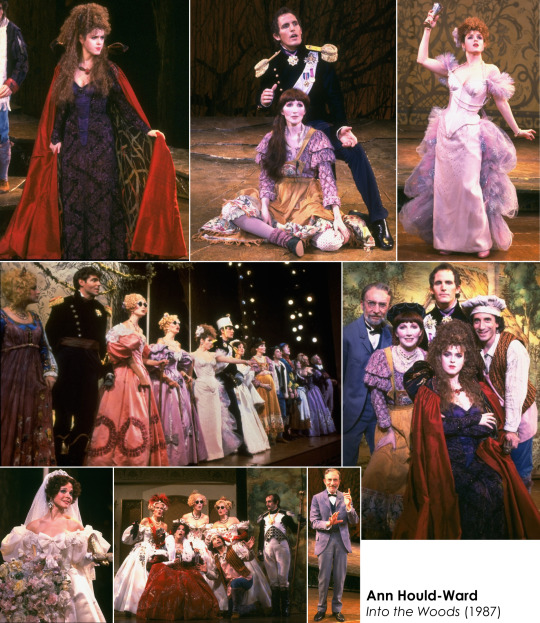
This highly involved principle demonstrates another manner of inventive design that uses a different method but maintains the aim of particularity as discussed previously with Patricia and Irene’s complex dyeing and re-dyeing process. Pushing the confines of what is possible with the materials at hand to create a variety of colours, shades, and textures ultimately produces visual entities that are complex to look at. Confusing the eye like this “holds attention longer”, Ann maintains, which makes viewers look more intricately at individual segments of the production, and enables the costume design to guide specific focus by not immediately ceding attention elsewhere.
Understanding the methods behind the resultant impacts of a show can be as, if not more, important and interesting than the final product of the show itself sometimes. A phone call Ann had last August with James Lapine reminds us this is a notion we may be treated more to in the imminent future, when he called to enquire as to the location of some design sketches for the book he is working on (Putting It Together: How Stephen Sondheim and I Created 'Sunday in the Park with George') to document more thoroughly the genesis of the pair’s landmark and beloved musical.
In continuation of the notion that origin stories contain their own intrinsic value beyond any final product, Ann first became Pat’s intern through a heart-warming and tenacious tale. Ann sent letters to three notable designers when finishing graduate school. Only Patricia Zipprodt replied, with a message to say she “didn’t have anything now but let me think about it and maybe in the future.” It got to the future, and Ann took the encouragement of her previous response to try and contact Pat again. Upon being told she was out of town with a show, Ann proceeded to chase Pat through various phone books and telephone wires across different states and theatres until she finally found her. She was bolstered by the specifics of their call and ran off the phone to write an imploring note – hinging on the premise of a shared connection to Montana. She took an arrow, stabbed it through a cowboy hat, put it in a box with the note that was written on raw hide, and mailed it to New York with bated breath and all of her hopes and wishes.
Pat was knife-edgingly close to missing the box, through a matter of circumstance and timing. Importantly, she didn’t. Ann got a response, and it boded well: “Alright alright alright! You can come to New York!”
Subsequently, Ann’s long career in the design world of the theatre has included notable credits such as: Sunday in the Park with George (1984) Into the Woods (1987, 1997) Falsettos (1992) Beauty and the Beast (1994, 1997) Little Me (1998) Company (2006) Road Show (2008) The People in the Picture (2011) Merrily We Roll Along (1985, 1990, 2012, segment in Six by Sondheim 2013) Passion (2013) The Visit (2015) The Color Purple (2015) The Prince of Egypt (2021)
From early days in the city sleeping on a piece of foam on a friend’s floor, to working collaboratively alongside Pat, to using what she’d learnt from her mentor in designing whole shows herself, and going on to win prestigious awards for her work – the cycle of the theatre and the importance of handing down wisdom from those who possess it is never more evident.
As Ann summarises it meaningfully, “the theatre is a continuing, changing, evolving, emotional ball”. It’s raw, it’s alive, it needs people, it needs stories, it needs documentation of history to remember all that came before.
In periods where there can physically be no new theatre, it’s made ever the more clear for the need not to forget what value there is in the tales to be told from the past.
Through this retrospective, we’ve seen the tour de force influence of a relatively small handful of women shaping a relatively large portion of the visual scape of some of Broadway’s brightest moments.
But it’s significant to consider how disproportionate this female impact was, in contrast with how massively male dominated the rest of the creative theatre industry has been across the last century.
Assessing variations in attitudes and approaches to relationships and families in these women in the context of their professional careers over this time period presents interesting observations. And indeed, manners in which things have changed over the past hundred years.
As Ann Hould-Ward speaks of her experiences, one of her reflections is how much this was a “very male dominated world”. And one that didn’t accommodate for women with families who also wanted careers. As an intern, she didn’t even feel she could tell Patricia Zipprodt about the existence of her own young child until after 6 months of working with her. With all of these male figures around them, it would be often questioned “How are you going to do the work? How are you going to manage [with a family]?”, and that it was “harder to convince people that you were going to be able to do out-of-towns, to be able to go places.” Simply put, the industry “didn't have many designers who were married with children.”
Patricia herself in the previous generation demonstrates this restricting ethos. “In 1993, Zipprodt married a man whose proposal she had refused some 43 years earlier.” She had just newly graduated college and “she declined [his proposal] and instead moved to New York.” Faced with the family or career conundrum, she chose the latter. By the 1950s, it then wasn’t seen as uncommon to have both, it was seen as impossible.
Her husband died just five years after the pair were married in 1998, as did Patricia herself the following year. One has to wonder if alternative decisions would’ve been made and lives lived differently if she’d experienced a different context for working women in her younger life.
But occupying any space in the theatre at all was only possible because of the efforts of and strides made by women in previous generations.
When Aline Bernstein first started designing for Broadway theatre in 1916, women couldn’t even vote. She became the first female member of the United Scenic Artists of America union in 1926, but only because she was sworn in under the false and male moniker of brother Bernstein. In fact, biographies often centralise on her involvement in a “passionate” extramarital love affair with novelist Thomas Wolfe – disproportionately so for all of her remarkable contributions to the theatrical, charitable and academic worlds, and instead having her life defined through her interactions with men.
As such, it is apparent how any significant interactions with men often had direct implications over a woman’s career, especially in this earlier half of the century. Only in their absence was there comparative capacity to flourish professionally.
Irene Sharaff had no notable relationships with men. She did however have a significant partnership with Chinese-American painter and writer Mai-mai Sze from “the mid-1930s until her death”. Though this was not (nor could not be) publicly recognised or documented at the time, later by close acquaintances the pair would be described as a “devoted couple”, “inseparable”, and as holding “love and admiration for one another [that] was apparent to everyone who knew them.” This manner of relationship for Irene in the context of her career can be theorised as having allowed her the capacity to “reach a level of professional success that would have been unthinkable for most straight women of [her] generation”.
Moving forwards in time, Irene and Mai-mai presently rest where their ashes are buried under “two halves of the same rock” at the entrance to the Music and Meditation Pavilion at Lucy Cavendish College in Cambridge, which was “built following a donation by Sharaff and Sze”. I postulate that this site would make for an interesting slice of history and a perhaps more thought-provoking deviation for tourists away from being shepherded up and down past King’s College on King’s Parade as more usually upon a visit to Cambridge.
In this more modern society at the other end of this linear tree of remarkable designers, options for women to be more open and in control of their personal and professional lives have increased somewhat.
Ann Hould-Ward later in her career would no longer “hide that [she] was a mother”, in fear of not being taken seriously. Rather, she “made a concerted effort to talk about [her] child”, saying “because at that point I had a modicum of success. And I thought it was supportive for other women that I could do this.”
If one aspect passed down between these women in history are details of the craft and knowledge accrued along the way, this statement by Ann represents an alternative facet and direction that teaching of the future can take. Namely, that by showing through example, newer generations will be able to comprehend the feasibility of occupying different options and spaces as professional women. Existing not just as designers, or wives, or mothers, or all, or one – but as people, who possess an immense talent and skill. And that it is now not just possible, but common, to be multifaceted and live the way you want to live while working.
This is not to say all of the restrictions and barriers faced by women in previous generations have been removed, but rather that as we build a larger wealth of history of women acting with autonomy and control to refer back to, things can only get easier to build upon for the future.
Who knows what Broadway and theatre in general will look like when it returns – both on the surface with respect to this facet of costume design, and also more deeply as to the inner machinations of how shows are put together and presented. The largely male environment and the need to tick corporate and commercial boxes will not have vanished. One can only hope that this long period of stasis will have foregrounded the need and, most importantly, provided the time to revaluate the ethos in which shows are often staged, and the ways in which minority groups – like women – are able to work and be successful within the theatre in all of the many shows to come.
Notable sources:
Photographs – predominantly from the New York Public Library digital archives. IBDB – the Internet Broadway Database. Broadway Nation Podcast (Eps. #17 and #18), David Armstrong, featuring Ann Hould-Ward, 2020. Behind the Curtain: Broadway’s Living Legends Podcast (Ep. #229), Robert W Schneider and Kevin David Thomas, featuring Ann Hould-Ward, 2020. Sense of Occasion, Harold Prince, 2017. Everything Was Possible: The Birth of the Musical ‘Follies’, Ted Chapin, 2003. Finishing the Hat: Collected Lyrics (1954–1981) with Attendant Comments, Principles, Heresies, Grudges, Whines and Anecdotes, Stephen Sondheim, 2010. The Complete Book of 1970s Broadway Musicals, Dan Deitz, 2015. The Complete Book of 1980s Broadway Musicals, Dan Dietz, 2016. Inventory of the Patricia Zipprodt Papers and Designs at the New York Public Library, 2004 – https://www.nypl.org/sites/default/files/archivalcollections/pdf/thezippr.pdf Extravagant Crowd’s Carl Van Vecten’s Portraits of Women, Aline Bernstein – http://brbl-archive.library.yale.edu/exhibitions/cvvpw/gallery/bernstein.html Jewish Heroes & Heroines of America: 150 True Stories of American Jewish Heroism – Aline Bernstein, Seymour Brody, 1996 – https://www.jewishvirtuallibrary.org/aline-bernstein Ann Hould-Ward Talks Original “Into the Woods” Costume Designs, 2016 – https://www.youtube.com/watch?v=4EPe77c6xzo&ab_channel=Playbill American Theatre Wing’s Working in the Theatre series, The Design Panel, 1993 – https://www.youtube.com/watch?v=9sp-aMQHf-U&t=2167s&ab_channel=AmericanTheatreWing Journal of the History of Ideas Blog, Mai-mai Sze and Irene Sharaff in Public and in Private, Erin McGuirl, 2016 – https://jhiblog.org/2016/05/16/mai-mai-sze-and-irene-sharaff-in-public-and-in-private/ Irene Sharaff’s obituary, The New York Times, Marvine Howe, 1993 – https://www.nytimes.com/1993/08/17/obituaries/irene-sharaff-designer-83-dies-costumes-won-tony-and-oscars.html Obituary: Irene Sharaff, The Independent, David Shipman, 2011 – https://www.independent.co.uk/news/people/obituary-irene-sharaff-1463219.html Broadway Design Exchange – Florence Klotz – https://www.broadwaydesignexchange.com/collections/florence-klotz Obituary: Florence Klotz, The New York Times, 2006 – https://www.nytimes.com/2006/11/03/obituaries/03klotz.html
#bernadette peters#sunday in the park with george#costume design#costume designers#stephen sondheim#sondheim#broadway#theatre#tony awards#oscars#academy award nominations#ethel merman#judy garland#into the woods#theater#musical theater#fashion#dresses#meryl streep#elizabeth taylor#old hollywood#film#costumes#movies#musicals#writing#long reads#hollywood#actresses
163 notes
·
View notes
Text
ROUGH ROAD TO TOP
August 16, 1953
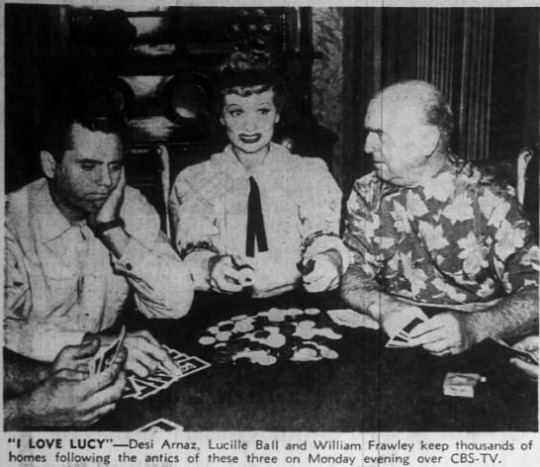
(1)

One of the more famous CBS-TV shows is “I Love Lucy.”
Its two chief characters - Lucille Ball and Desi Arnaz - have had a rocky road to their present status as one of the top comedy teams in the country.
At the end of Lucille's first year in dramatic school she was told by her teachers that she was wasting her time and money, that she would never become an actress. She was fired from all four of her first jobs as a chorus girl. Later, as a model, she almost lost her life in an automobile accident and was told she would never walk again.
Revolution Factor
It was a revolution in Cuba and a mishap in World War II which were fateful turns in Arnaz’ trip to stardom. The Cuban revolution destroyed his family’s wealth, drove them to the United States. World War II got him a broken kneecap in basic training, and since he had been a professional entertainer, he was placed in limited service and assigned to entertain hospitalized G.I.s'.
Columbia Pictures gave Lucille a contract as a stock player, and, convinced that her luck finally had turned, she sent for mother, grandfather, and sister to join her in California. But, the morning after she wired her family, the studio decided to dissolve its stock company. When the family arrived, Lucille was working as an extra at Paramount.
Bit parts and extra roles in a number of pictures kept Lucille busy, but not prosperous, until she was cast in ’"Roberta.” RKO officials, impressed by her work, gave her a contract. When not busy before the cameras, she was a mainstay of the studio's Little Theater. (2)
Offered Stage Lead
Her performance in the second lead in “The Girl from Paris" (3) drew Broadway's attention to Miss Ball and she was offered a lead in the musical "Hey Diddle Diddle.” After satisfying her yen to perform on the Great White Way (4), she returned to Hollywood for "Stage Door” and “Too Many Girls.” In the latter picture, she was costarred with Desi Arnaz. They were married Nov. 30 1940 in Greenwich, Conn.
Back from her honeymoon, Lucille walked into her first really big break a role in "The Big Street,” based on a story by Damon Runyon (5). Overnight it made her a star.
Her first assignment at M.G.M. in 1942 was the title role in the Technicolor production "Du Barry Was a Lady” (6). Stellar roles followed in "Best Foot Forward” and "Meet the People" (7). After completing "Easy to Wed” with Van Johnson (8), she headed for New York to be with her husband, then out of the army and on his way to success in the orchestra business.
Starred on Tour
Shortly after completing "Her Husband’s Affairs,” (9) Miss Ball went on tour as star of Elmer Rice's play "Dream Girl” (10) then worked with Sonny Tufts and Victor Mature in "Interference” for R.K.O. (11)
Lucille, Desi, arid their year-old daughter Lucy Desiree, live at Desilu, their five-acre ranch at Chatsworth, Calif. They raise cattle, chickens, dogs, and cats and dabble in farming. Enthusiastic fishermen they spend a lot of time on their boat.
Desiderio Alberto Arnaz y de Acha was born in Santiago, Cuba, son of the mayor. Desi’s mother, Dolores de Acha, was considered among the 10 most beautiful women In Latin America.
Three ranches totaling 100,000 acres, a palatial home in the city, a private island in Santiago Bay, speedboats, a fleet of motor cars, and a racing stable were all at the command of the youthful Desi during the pre-revolutionary days. His father, after eight years as mayor of Santiago, was made a member of the Cuban congress In 1932.
On Aug. 12, 1933, came the revolution. Congress was dissolved. Its members jailed. The Arnaz property was confiscated, the homes burned to the ground. In 24 hours everything was gone except $500 Desi's mother had hidden. Desi and mother fled to Miami, devoted the next six months to efforts to free Papa Arnaz. from prison. They were finally reunited in Florida.
For Desi, life in these United States for several years was hard but interesting: he worked at truck driving, train yard checking, taxi driving, bookkeeping, and, of all things, bird cage cleaning. Desi’s father managed to launch an importing business. It went broke when a shipment of fruit spoiled in transit.
Show business at this point finally caught up with Desi. His first job was playing guitar and singing with a seven-piece rhumba band at Miami’s Roney-Plaza Hotel (12). Xavier Cugat (13) spotted him, was impressed with this Cuban boy who was to be dubbed "The Tempo” by critics of modem music. After a year as featured vocalist with the Cugat band, Desi organized his own group of musicians and moved into the swank La Conga Café in Miami (14).
George Abbott's Broadway hit "Too Many Girls” (15) was Desi’s next step up the ladder, in 1939. He played a Cuban football player, one of the leads, and played tropical drums. RKO bought the film rights and signed Desi to play his stage role. When the shooting was over Desi married the leading lady, Lucille Ball.
He spent from Feb. 1943 to Nov. 1945 in the Army, after which he toured the nation with his band playing theaters, dances, night clubs. He hasn’t been without a band since. In 1948, Desi made the Columbia film "Holiday in Havana.” (16)
He made a vaudeville tour with Lucille Ball and that convinced them they’d do well as a husband-and-wife team on television. The tour inspired the CBS-TV show “I Love Lucy,” which has been highly rated since it started. (17)
Desi Arnaz’s personality is as vibrant as the music he makes. He is friendly, direct in manner, has flashing dark brown eyes and brown hair. He’s an avid fisherman, rides and swims expertly: his tennis is the envy of his San Fernando Valley neighbors, Sue and Alan Ladd, Francis Lederer, Jackie Oakie, and the Andrews Sisters. (18) A good cook, he specializes in such tempting dishes as Ginger Beef and Bouillabaisse.
# # #
FOOTNOTES FROM THE FUTURE

(1) The photo is from “Be a Pal” (ILL S1;E2) aired on October 22, 1951, nearly two years earlier. There’s one thing missing from this file photo: Vivian Vance. The success of the show was its foursome, not threesome! If you look closely you can see the hands of the other poker players, Richard Reeves (Hank, left) and Tony Michaels (Charlie, right).
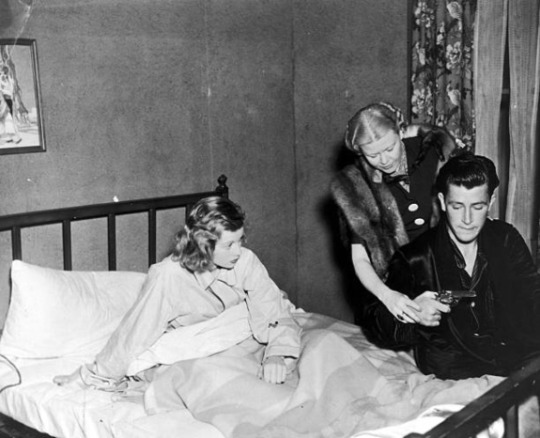
(2) Lucille did several plays at the RKO Little Theatre under the direction of Lela Rogers (above), Ginger’s mom. When Lucille later bought RKO, she dubbed it the Desilu Playhouse, a training ground for new young performers, often hand selected by Ball herself.
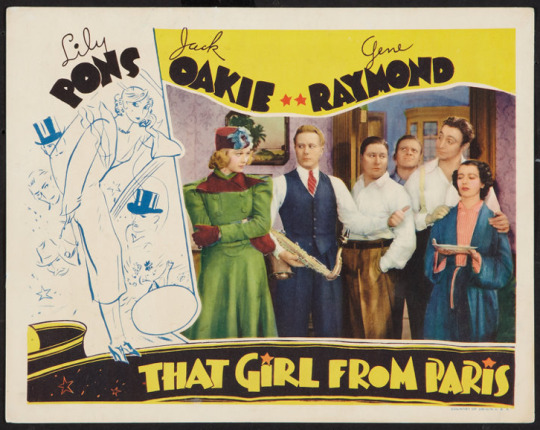
(3) “That Girl from Paris” (not “The” as the article states) was Lucille’s 33rd film. The light-hearted musical romance earned an Oscar nomination for Sound Recording. It was released on the first day of 1937.
(4) Lucille was indeed cast in the Broadway-bound comedy (it was not a musical, however) “Hey Diddle Diddle!” It opened in Princeton, New Jersey, the first of several out-of-town stops on the way to Broadway. What Lucille’s publicity omits is that the show never got further than Washington DC due to the serious illness of its leading man, Conway Tearle. So Lucy’s Broadway debut would have to wait - until 1960!
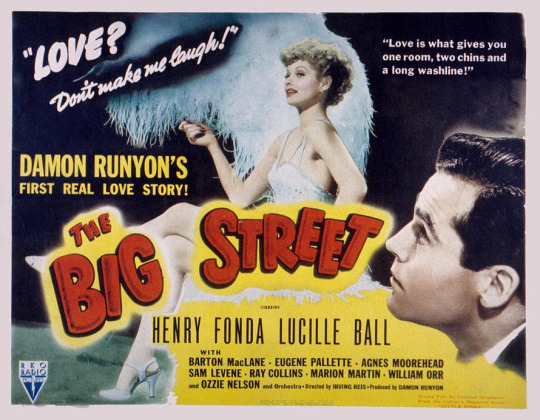
(5) “The Big Street” opened on September 4, 1942. It was based on a Damon Runyan short story about a night club singer (Lucille) embittered by an accident that left her in a wheelchair and her romance with a naïve admirer (Henry Fonda) named Pinks. Lucy later said it was her favorite of the many films she made. It was her 55th film.
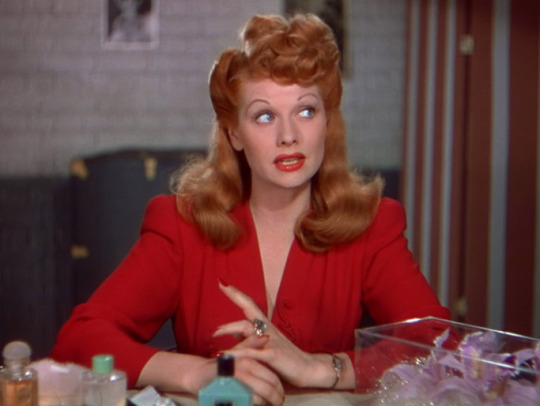
(6) “Du Barry Was A Lady” premiered in August 1943. It was Lucille’s 57th film, but her first for MGM. She nabbed the role from her friend Ethel Merman, who had done the Cole Porter musical comedy on Broadway. It was filmed in color, and was the film that earned her the nickname “Technicolor Tessie” because of her bright orange hair - a color she committed to from then on, despite her roots! This is the film that introduced Lucy to the song “Friendship”, which she would also sing on “I Love Lucy.”
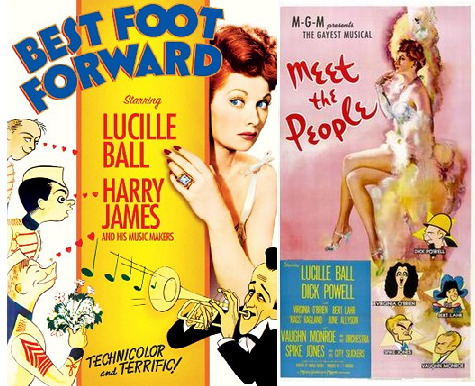
(7) In the musical comedy “Best Foot Forward” (1943) Lucille Ball played herself. It was her 58th film. “Meet The People” (1944) was a romantic comedy for MGM, Ball’s 60th film.
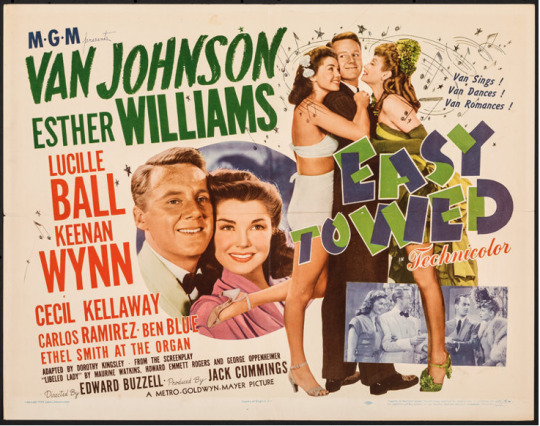
(8) In 1946 she released her 63rd film, “Easy To Wed” co-starring Van Johnson and Esther Williams. Lucille and Van had appeared together in “Too Many Girls” and he would appear on Lucy’s television shows.
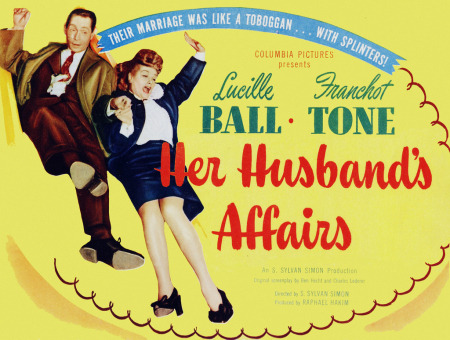
(9) “Her Husband’s Affairs” (1947) was a romantic farce with Lucy teamed with Franchot Tone. It was her 69th film.

(10) Back to the stage, Lucille accepted the leading role in a revival tour of “Dream Girl” a fantasy comedy by Elmer Rice. Once again, the play launched in Princeton, but this time Broadway was not the goal. It had already played the Great White Way two years earlier. The play toured the country at select cities, landing Lucille back in California in late 1947. In one SoCal gig she was appearing simultaneously with Desi and his band just a few blocks away. No doubt this was by design.

(11) RKO’s “Interference” was re-named “Easy Living” (1949) and dealt with the world of professional sports, namely football. It co-starred Victor Mature and Sonny Tufts. It was Ball’s 71st film.

(12) The luxurious Roney Plaza Hotel in Miami Beach was located on the corner of Collins Avenue and 23rd Street. It opened in 1925 and was demolished in 1968. The resort attracted a who's who that included Hollywood stars and even the Duke and Duchess of Windsor. The hotel's Bamboo Room & Restaurant was the place to be seen on the Beach for decades.
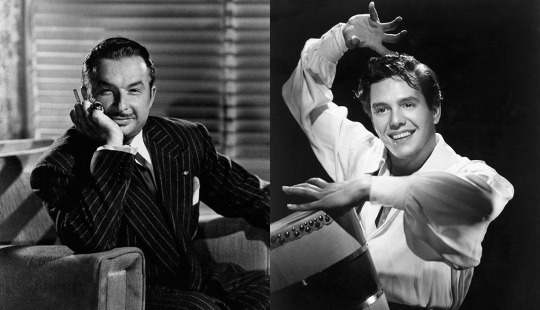
(13) Xaviar Cugat (1900-1990) was a Spanish musician and bandleader who spent his formative years in Havana, Cuba. A trained violinist and arranger, he was a leading figure in the spread of Latin music. In New York City he was the leader of the resident orchestra at the Waldorf–Astoria before and after World War II. He was a mentor and friend to Desi Arnaz, who kept his name before the public by making him a rival of Ricky Ricardo on “I Love Lucy” where his name became a punchline. In reality, Desi was grateful to Cugat, not jealous of him!
“I learned a lot from Xavier Cugat” ~ Desi Arnaz

(14) La Conga Café was located in New York City, not Miami, although the article may be referring to a different, lesser known establishment where Desi Arnaz performed. He became a regular headliner at La Conga, even issuing a record titled “La Conga” in 1939.

(15) Speaking of 1939 New York, Desi appeared in his only Broadway show in 1939, Rogers and Hart’s “Too Many Girls.” When the film rights were purchased by RKO, Desi was hired by director George Abbott to recreate his role. It was while filming this movie that he met Lucille Ball.

(16) “Holiday in Havana” was a Columbia picture released in October 1949. The film is about a Cuban hotel busboy (Arnaz) who dreams of becoming a composer. His love interest was not Lucy, but Mary Hatcher.

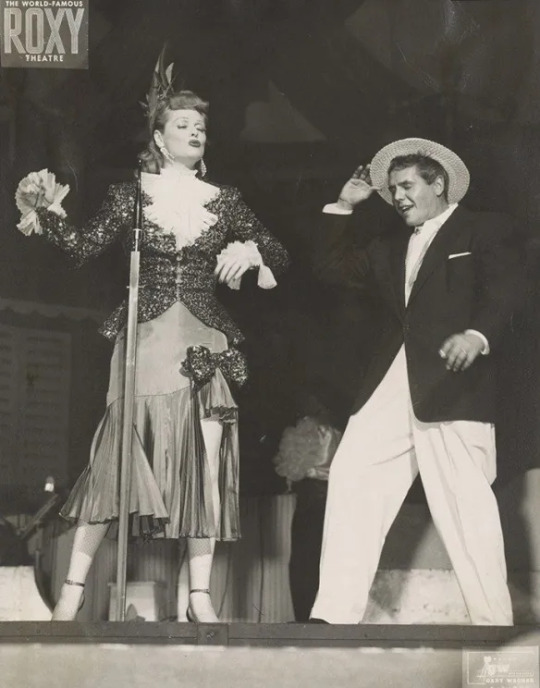
(17) The Tour incorporated some of the same routines seen in the “I Love Lucy” pilot as well as early episodes of the series, most notably the “Cuban Pete / Sally Sweet” duet. The tour culminated at the Roxy in New York City, where Desi was playing when he married Lucille in 1940.
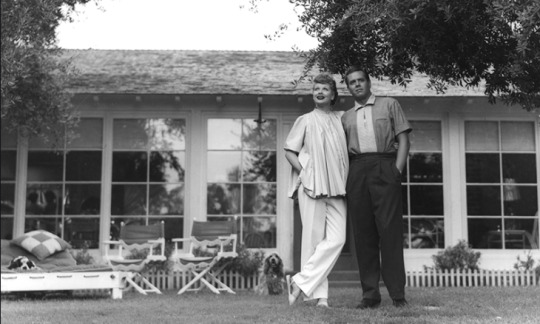
(18) Before moving to their Beverly Hills mansion, Lucy and Desi lived on a ranch in Chatsworth in San Fernando Valley. They dubbed their ranch home Desilu. About their neighbors:
Alan Ladd (1913-64) was a chorus boy when Lucille was an Earl Carroll showgirl in Murder at the Vanities (1934). He was married to Sue Carol (1906-82) from 1942 until his death. Carol’s name was mentioned on “I Love Lucy” in “The Fashion Show” when Lucy selects the same Don Loper original that Carol has chosen to wear in the fashion show. She does not appear on screen.
Francis Lederer (1899-2000) was a Hungarian-born actor. In 1960 he did an episode of Desilu’s “The Untouchables”. From 1941 until his death he was married to Marion Irvine.
Jackie Oakie (1903-78) did four films with Lucille Ball between 1934 and 1938, including both “Annabell” movies.
The Andrews Sisters were the pre-eliminant close-harmony girl group of their time. The consisted of Patty, Maxine, and LaVerne. They were mentioned on “I Love Lucy” in “Be a Pal” in the same scene that the photo at the top of the article came from. In 1969, Patty Andrews guest-starred as herself on “Here’s Lucy”. Lucy and Lucie played the other two Andrews sisters.
13 notes
·
View notes
Text
by Barbara Waldinger
Frankie Addams, a lonely, twelve-year-old girl whose brother Jarvis and his fiancée Janice are about to get married, has decided (uninvited) to join the couple on their honeymoon and move in with them: “I love them so much,” they are “the we of me.” Despite the fact that Frankie has undertaken to change her name to F. Jasmine to coordinate with theirs, she will inevitably be left behind, threatening to die rather than to live on in this stiflingly small Southern town.
This is the setting of Carson McCullers’ play, The Member of the Wedding, produced by the Williamstown Theatre Festival—the only revival in a 2018 season filled with premieres. Director Gaye Taylor Upchurch and her cast approach this 1950 classic as they would a new play: by asking rigorous questions in rehearsal and taking nothing for granted. Adapted by McCullers from her 1946 novel, the production ran for just over 500 performances on Broadway, starring Ethel Waters, Julie Harris and seven-year-old Brandon deWilde, all of whom reprised their roles for a 1952 film adaptation. McCullers, who grew up in Georgia and was ill for much of her short life (she died at age 50), achieved fame for her debut novel, The Heart is a Lonely Hunter, which was also filmed.
The Member of the Wedding is not plot-driven, but instead focuses on the time period, the place, and its three major characters. The time is 1945: Frankie’s brother Jarvis is a soldier serving in Alaska, while newspaper articles announce the dropping of the atom bomb. Racial issues abound: the American military was segregated, Jim Crow laws were in effect in the south, and there was an upsurge of lynchings. Many of the victims were black soldiers returning from the war.
This slideshow requires JavaScript.
At Williamstown, the excellent design team provides visual representation of the location and time: the lovely set (designed by Laura Jellinek) consists of the small period kitchen and large yard of the Addams house in an unnamed town, complete with an arbor and curtains where Frankie (Tavi Gevinson), an amateur playwright, invents and performs her own plays, along with her younger cousin, John Henry West (Logan Schuyler Smith). Clint Ramos’s splendid costumes figure prominently in the production, contextualizing it, but they also reveal character by illustrating the wild get-ups used by Frankie and John Henry in their play-acting as well as the over-the-top orange ruffled gown Frankie purchases for her brother’s wedding. The beautifully atmospheric lighting (by Isabella Byrd) suggesting long summer days and evening shadows, is complemented by the perpetual neighborhood noises supplied by Bray Poor, whose original music includes a piano being tuned, trumpets blaring, and a haunting piano finale as the curtain falls.
The three characters whose lives and longings fill this play are Frankie, John Henry, and Berenice Sadie Brown (Roslyn Ruff), nominally the Addams’ cook but so much more. Today we would call Frankie “gender fluid,” with her masculine name and clothing (features she shares with McCullers herself), and her blond crew-cut. One of the opening lines of the novel defines Frankie: “She belongs to no club and was a member of nothing in the world.” So in the play. Her one friend moved away, the girls’ club next door rejects her application to join, and now she throws herself headlong into a doomed attempt to be a member of the upcoming wedding of her brother (Tom Peckinka) to his pretty fiancée Janice (Louisa Jacobson). The family history is bleak: her mother died giving birth to Frankie, and her father (James Waterston), a racist who spends nearly all his time in his jewelry store, doesn’t really know or care to know his daughter. Only Berenice understands and comforts her. She is a true mother to both Frankie and young John Henry, whose mother (Liv Rooth) lives next door but is rarely seen.
John Henry is blithely unclear about his identity: sporting blond curls, he loves to dress up in female clothing, play with dolls, and wishes that each child could be half boy and half girl. Smith is adorable, as he runs, jumps and cartwheels across the stage, blowing bubbles and hiding under the kitchen table, curling up in Berenice’s arms, seeking to be loved. Frankie, whose adolescent rebelliousness and self-destructive behavior makes her harder to love, is fully inhabited by Gevinson as she careens from one crisis to another, suffering from panic attacks, and desperately needing Berenice’s steadying hand.
Ruff’s Berenice is also lonely—having lost her beloved first husband Ludie to pneumonia, she proceeded to remarry three more times, each husband seeming to resemble “pieces of Ludie” but always “the wrong pieces.” She hates to be alone, but isn’t in love with her boyfriend T. T. Williams (Leon Addison Brown) and spends much time and emotion worrying about her volatile foster brother, Honey Camden Brown (Will Cobbs). Ruff gives a beautifully understated performance, never afraid to tell the children her honest opinion, sharing her feelings without regard to their youth, humming through difficult moments, and visibly trying to protect her charges from life’s blows.
The first act belongs to Frankie, as she rages against her existence in this “empty ugly house,” which can get tiresome and repetitious, despite Gevinson’s mastery of her character. But the second act, dominated by Berenice, contains the payoff. Movingly and meticulously directed by Upchurch and flawlessly performed, this act fully justifies a revival of The Member of the Wedding.
THE MEMBER OF THE WEDDING runs from August 5—19. Tickets may be purchased online at wtfestival.org or call 413-458-3253.
Williamstown Theatre Festival presents THE MEMBER OF THE WEDDING by Carson McCullers. Directed by Gaye Taylor Upchurch. Cast: Roslyn Ruff (Berenice Sadie Brown), Tavi Gevinson (Frankie Addams), Logan Schuyler Smith (John Henry West), Tom Pecinka (Jarvis), Louisa Jacobson (Janice), James Waterston (Mr. Addams), Liv Rooth (Mrs. West), Vinie Burrows (Sis Laura), Leon Addison Brown (T. T. Williams), Will Cobbs (Honey Camden Brown), Ben Ahlers (Barney MacKean), Delilah Napier (Helen Fletcher), Sarah Haga (Doris).
Scenic Design: Laura Jellinek; Costume Design: Clint Ramos; Lighting Design: Isabella Byrd; Original Music and Sound Design: Bray Poor; Hair and Wig Design: Leah Loukas; Dialect Coach: Charlotte Fleck; Production Stage Manager: Lindsey Turteltaub.
Running Time: Two hours 30 minutes including intermission. Williamstown Theatre Festival, Mainstage, 1000 Main Street, Williamstown, MA., from August 5; closing August 19.
REVIEW: “The Member of the Wedding” at the Williamstown Theatre Festival by Barbara Waldinger Frankie Addams, a lonely, twelve-year-old girl whose brother Jarvis and his fiancée Janice are about to get married, has decided (uninvited) to join the couple on their honeymoon and move in with them: “I love them so much,” they are “the we of me.” Despite the fact that Frankie has undertaken to change her name to F.
#Barbara Waldinger#Ben Ahlers#Bray Poor#Carolyn Brown#Carson McCullers#Charlotte Fleck#Clint Ramos#Daniel Rader#Delilah Napier#Gaye Taylor Upchurch#Isabella Byrd#James Waterston#Laura Jellinek#Leon Addison Brown#Liv Rooth#Logan Schuyler Smith)#Louisa Jacobson#Mandy Greenfield#Roslyn Ruff#Sarah Haga#Tavi Gevinson#The Member of the Wedding#Tom Pecinka#Vinie Burrows#Will Cobbs#Williamstown MA#Williamstown Theatre Festival#WTF
0 notes
Text
More Than Meets The Eye: Celebrating Wes Craven’s Classic THE HILLS HAVE EYES
It’s hard to imagine now, but back in the late 70’s Wes Craven was still an up-and-coming filmmaker. In 1972, he had shocked the world with his brutal directorial debut The Last House on the Left and it wasn’t long before he returned to the world of horror. On July 22, 1977 the now classic The Hills Have Eyes was released. On the surface the film is simply a tale of an unfortunate family, stranded in the desert who is brutally attacked, terrorized and hunted by a group of desert dwelling savages. Upon closer inspection however, the film offers a wealth of interesting dualities both in the narrative, and in the actual making of the film. Today marks its 41st anniversary and therefore it’s the perfect time to delve a bit deeper into this iconic movie.
youtube
Like any good story, we should start at the beginning. Right off the bat we are introduced to the Carter family. Bob and Ethel Carter (played by Russ Grieve and Virginia Vincent) are joined on their family vacation by their son Bobby (Robert Houston) and daughters Brenda (Susan Lanier) and Lynne (Dee Wallace). Also joining the Carter family is Lynne‘s husband Doug (Martin Speer) and their newborn baby. The Carter family is the picture perfect American family. Bobby and Brenda both young, fit, blonde and beautiful. Lynne and Doug both young, in love and brand new parents. Bob is a strong, domineering father figure and Ethel his loving and submissive wife. After stopping at a dilapidated gas station and taking an ill-advised short cut, Bob crashes the family’s car and the attached trailer in the middle of the desert. This sets the stage and the backdrop that the rest of the film will play out upon.
The film was shot outside Victorville, California, truly in the middle of the desert, and here is one of the most obvious dualities of the film. During the day temperatures could soar above 90 degrees, while at night it would plummet to near 40 degrees. The stark rocky terrain punctuated by only the sparsest foliage, and mostly dry and dying at that. The family, surrounded by this expansive empty space, hovers around their trailer and car. There are numerous shots where these two ideas play off each other. The landscape of the area is commonly shown with long, distant and expansive shots. This is coupled with close, almost intrusive shots of the family while they’re driving and crashing their car. Once the car has been rendered immovable, the family trailer is shown. The space is small, crowded and nearly claustrophobic. Here they are surrounded by countless miles of vastness, and yet confined all the same.
It’s not long before we are properly introduced to the other family in the film, led by Papa Jupiter (James Whitworth). Papa Jupiter is a brutal man who killed his own mother, and later his father (the gas station owner Fred). According to Fred in a revealing speech to Bob, Jupiter was always a violent person. As a kid he would kill livestock and even his own sister. After Fred tried to kill Jupiter and left him for dead, Jupiter took to the hills. This disturbed personality is the flip-side to Bob, a retired police officer who only quit the force because of his bad heart. Even physically the two differ with Bob being out of shape, physically at a disadvantage and dependent on his gun for protection. Jupiter on the other hand, while scarred and mutilated, is fast, strong and intimidating. But Jupiter is not alone in the hills. Jupiter has a wife of sorts known only as Mama (Cordy Clark). She was an alcoholic and a prostitute and would give Jupiter three sons and a daughter; Mars (Lance Gordon), Pluto (Michael Berryman), Mercury (Peter Locke) and Ruby (Janus Blythe). Mama is distant and uninterested, the exact opposite of Ethel who is loving, present and sweet. You can see where this is going. Just like their respective moms and dads, the kids are also near opposites of each other.
Jupiter‘s clan are harsh and uncivilized. When Pluto and Mars attack the family in their trailer, they make moves that are shocking and unthinkable to “normal” people like the Carter‘s. Pluto sexually assaults young Brenda while Mars gives no thought to killing Ethel and young mother Lynne. He also absconds with Lynne‘s new baby, saying simply “Baby’s fat.” While these events are obviously partially story driven, they also clearly represent the vast divide between the two groups. This is also the first real clear look we get at Pluto and Mars and their scruffy, dirty, bone clad appearances. A visual counterpart to the Carter‘s clean cut, well-groomed looks.
Accompanying the Carter family are their two German Shepherd dogs, Beauty and Beast. Aside from the obvious dualities of their names, the dogs also represent nature in the film. It’s not just the Carter family who is up against nature, Jupiter‘s clan is also a victim to the harsh realities of the desert. That’s the whole reason they’re hunting the Carter family in the first place; food has become sparse for them and they’re running out of options. Beauty quickly becomes a victim, however Beast proves to be a much more formidable character. His showdown with Pluto near the end is a true man versus beast fight and one of the most graphic scenes in the film. This idea is also referenced in another small, but clever way. Inside the trailer hangs a giant poster from the movie Jaws; a nod to the power of nature.
When it came to scoring the film, Wes Craven called upon Don Peake. Rather than a traditional action driven score, Peake created a score that not only conveyed the brutality of the film, but also the many things discussed so far. Utilizing a mix of electronic and acoustic instruments, Peake composed a score that comes across as stark and alien. The sounds compliment the harshness of the environment and are used in very strategic ways. In the intense trailer scene where the mothers meet their fate, there is notably a distinct lack of score. The scene is left to play out without any musical accompaniment and thus gives even more weight and power to the scene. It’s only near the end of the film where roles and lines begin to blend do we begin to hear a more traditional score. None of this is by accident and I encourage you to pay special attention to what you’re hearing, or not hearing, next time you watch the film.
Near the end, all the lines begin to blur. At this point the Carter family is down 3 members and missing one. Jupiter‘s clan are down 2. Realizing their dire circumstances, the remaining Carter’s step up to the plate and begin to truly fight back. Brenda comes up with an ingenious MacGyver like trap for Jupiter. (I personally love that she is the one to come up with this idea) Once Jupiter is relatively subdued, Bobby is able to finish the job and actually hit something for once with the gun he’s been brandishing the entire length of the film. Doug also pulls it together and goes after his young child. There’s truly only one character that rides both sides of the line in this movie, and that character is Ruby. From the beginning, she is the most reasonable member of Jupiter‘s clan and she remains that way throughout the entire film. She never attacks the Carter family, and she actually tricks her own brother Mars in order to help reunite Doug with his child. Realizing the damage that her family has done, Ruby goes so far as to incapacitate her mother and assists in the downfall of Mars. Her character is interesting and a statement of how one can break away from unfortunate circumstances and rise above them. *Cough* Watch The Hills Have Eyes 2 *Cough*
There is a reason why The Hills Have Eyes has stood the test of time and helped create the juggernaut that is Wes Craven. His attention to detail, story, aesthetics and his willingness to take risks is present in even his earliest works. While on the surface this film may appear to be a simple story, upon closer inspection there are numerous layers to be discovered. We have merely scratched the surface here today and I encourage you to celebrate its anniversary today with a rewatch of this classic. And if you do…remember…it’s only a film…it’s only a film…
What do you think about The Hills Have Eyes? Let us know over on our Facebook Group or on our Twitter!
The post More Than Meets The Eye: Celebrating Wes Craven’s Classic THE HILLS HAVE EYES appeared first on Nightmare on Film Street - Horror Movie Podcast, News and Reviews.
from WordPress https://nofspodcast.com/more-than-meets-the-eye-celebrating-wes-cravens-classic-the-hills-have-eyes/ via IFTTT
0 notes
Text
French Open 2018: Cameron Norrie pays tribute to late grandmother after defeat
French Open 2018: Cameron Norrie pays tribute to late grandmother after defeat
French Open 2018: Cameron Norrie pays tribute to late grandmother after defeat
Cameron Norrie has been playing at the French Open for the first time
French Open 2018 Venue: Roland Garros, Paris Dates: 27 May-10 June Coverage: Daily live radio and text commentaries on BBC Radio 5 live, the BBC Sport website and app.
British number three Cameron Norrie paid tribute to his late grandmother Ethel after he was knocked out of the French Open by 15th seed Lucas Pouille.
Norrie lost 6-2 6-4 5-7 7-6 (7-3) to the Frenchman when their second-round match was completed on Thursday.
But the 22-year-old revealed that his father David had missed his match to attend the funeral in Glasgow on Wednesday.
“I have fought the past two weeks so hard for her,” he told BBC Sport.
“I think she would be proud, and she played a lot of tennis herself.
“My dad had to go back on Tuesday night. It was tough and I think my dad just got back to Paris today and just missed the end of my match.”
Pouille, the French number one, led by two sets to one when bad light stopped play on Wednesday night.
In a tense fourth set, the Frenchman broke for 6-5 but he was unable to serve out for the match.
Norrie, who beat world number 10 John Isner on his way to reaching the semi-finals of the Lyon Open last week, forced a tie-break but the world number 85 was unable to take it to a decider.
He has enjoyed a sharp rise since making his debut on the ATP Tour last year, climbing into the top 100 for the first time last week.
It helped him automatically qualify for a Grand Slam for the first time in his career on his debut appearance at Roland Garros.
The New Zealand-raised left-hander had dropped the opening two sets on Wednesday and also appeared to be struggling with a stomach illness.
But he gave himself a chance by taking the third set and ensuring the match went to a second day.
“By the second or third game, I felt my stomach was sore so I was pumped to get off court last night,” he added.
“Today I felt a lot better. Yesterday I got a bit sidetracked and I couldn’t concentrate. I struggled to fall asleep a little last night.”
A taste for the big occasion – analysis
BBC Sport tennis correspondent Russell Fuller
In case we needed reminding, after his exploits in Marbella on his Davis Cup debut in February, Cameron Norrie has a taste for the big occasion.
All credit to Lucas Pouille for conjuring an ace when set point down, otherwise Norrie may well have had a final set to enjoy on his Philippe Chatrier court debut.
Instead, his second year as a professional will begin with a 70-something ranking next to his name. Norrie has already secured direct entry into Wimbledon and that ranking will ensure he does not need to worry about qualifying for the US Open, either.
As his Argentine coach Facundo Lugones told BBC Sport: “One of the few players who broke top 100 12 months after turning pro was John Isner – so it’s really tough to do what he’s doing now.”
Luck goes against Norrie in tie-break
American college educated Norrie began day two confidently and won his opening three service games before saving a couple of break points in the seventh game.
Inspired to play tennis?
Find out how to get into tennis in our special guide.
The Briton got a set point at 5-4 but Pouille saved it in style with an ace.
That looked to have turned the match the Frenchman’s way and he broke Norrie to 15 to leave him serving for the match.
But Norrie showed plenty of determination, taking the third of three break-point chances to force the tie-break.
Pouille held the advantage in the tie-break and luck was not on Norrie’s side when at 5-3 down he volleyed a winner but was judged to have touched the net.
That gave the Frenchman three set points but he only needed one to reach round three.
“It was great exposure for me, and I think I’m going to use the experience to my advantage in the future,” added Norrie.
BBC Sport – Tennis ultras_FC_Barcelona
ultras FC Barcelona - https://ultrasfcb.com/tennis/5043/
#Barcelona
0 notes
Photo

Happy Birthday to James Todd Smith (born January 14, 1968), known professionally as LL Cool J (short for Ladies Love CoolJames), is an American rapper, actor, author, and entrepreneur from Queens, New York. He is known for such hip hop hits as “I Can’t Live Without My Radio”, “I’m Bad”, “The Boomin’ System”, “Rock The Bells” and “Mama Said Knock You Out”, as well as romantic ballads such as “Doin’ It”, “I Need Love”, “Around the Way Girl” and “Hey Lover”.
LL Cool J is also known as one of the forefathers of pop rap. He has released 13 studio albums and two greatest hits compilations. His twelfth album Exit 13 (2008), was his last for his long-tenured deal with Def Jam Recordings. His latest album, Authentic, was released in April 2013. In 2010, VH1 considered him to be in their “100 Greatest Artists Of All Time” list.
LL Cool J has also appeared in numerous films, including In Too Deep, Any Given Sunday, S.W.A.T., Mindhunters, and Edison. He currently stars in an action role as NCIS Special Agent Sam Hanna, on the CBS crime drama television series NCIS: Los Angeles. LL Cool J is also the host of Lip Sync Battle on Spike.
Early life
LL Cool J was born James Todd Smith on January 14, 1968, in Bay Shore, New York, the son of Ondrea Griffeth (born January 19, 1946) and James Louis Smith, Jr. In an episode of Finding Your Roots, LL learned his mother was adopted by Eugene Griffith and Ellen Hightower. The series’ genetic genealogist CeCe Moore identified LL’s biological grandparents as Ethel Mae Jolly and Nathaniel Christy Lewis through analysis of his DNA. LL’s biological great-uncle was hall of fame boxer, John Henry Lewis.
He began rapping at age 9 and was influenced by hip-hop group The Treacherous Three. In March 1984, when NYU student Rick Rubin and promoter-manager Russell Simmons founded the then-independent Def Jam label, 16-year-old Hollis, Queens-native James Todd Smith was creating demo tapes in his grandparents’ home. His grandfather, a jazz saxophonist, bought him $2,000 worth of equipment, including two turntables, an audio mixer and an amplifier. Smith later discussed his childhood background and rapping, stating that “By the time I got that equipment, I was already a rapper. In this neighborhood, the kids grow up in rap. It’s like speaking Spanish if you grow up in an all-Spanish house. I got into it when I was about 9, and since then all I wanted was to make a record and hear it on the radio.” By using the mixer he had received from his grandfather, Smith produced and mixed his own demos and sent them to various record companies throughout New York City, including Simmons’ and Rubin’s own Def Jam Recordings.
In a VH1 documentary (Planet Rock: the Story of Hip Hop and the Crack Generation), LL Cool J, at 14 years of age, revealed that he initially wanted to call himself J-Ski but did not want to associate his stage name with the cocaine culture (the rappers who use “Ski” or “Blow” as part of their stage name e.g., Kurtis Blow, Joeski Love were associated with the rise of the cocaine culture as depicted in the 1983 remake of Scarface).
Under his new stage name, LL Cool J (an abbreviation for Ladies Love Cool James), Smith was signed by Def Jam, which led to the release of his first official record, the 12-inch single “I Need a Beat” (1984). The single was a hard-hitting, streetwise b-boy song with spare beats and ballistic rhymes. Smith later discussed his search for a label, stating “I sent my demo to many different companies, but it was Def Jam where I found my home.” That same year, Smith made his professional debut concert performance at Manhattan Center High School. In a later interview, LL Cool J recalled the experience, stating “They pushed the lunch room tables together and me and my DJ, Cut Creator, started playing. … As soon as it was over there were girls screaming and asking for autographs. Right then and there I said ‘This is what I want to do’.” LL’s debut single sold over 100,000 copies and helped establish both Def Jam as a label and Smith as a rapper. The commercial success of “I Need a Beat”, along with the Beastie Boys’ single “Rock Hard” (1984), helped lead Def Jam to a distribution deal with Columbia Records the following year.
Musical career
1985–1987: Radio
Radio was released to critical acclaim, both for production innovation and LL’s powerful rap. Released November 18, 1985, on Def Jam Recordings in the United States, Radio earned a significant amount of commercial success and sales for a hip hop record at the time. Shortly after its release, the album sold over 500,000 copies in its first five months, eventually selling over 1 million copies by 1988, according to the Recording Industry Association of America. Radio peaked at number 6 on the Top R&B/Hip-Hop Albums chart and at number 46 on the Billboard 200 albums chart. It entered the Top R&B/Hip-Hop Albums chart on December 28, 1985, and remained there for forty-seven weeks, while also entering the Pop Albums chart on January 11, 1986. Radio remained on the chart for thirty-eight weeks. By 1989, the album had earned platinum status from the Recording Industry Association of America (RIAA), after earning a gold certification in the United States on April 14, 1986, with sales exceeding one million copies. “I Can’t Live Without My Radio” and “Rock the Bells” were singles that helped the album go platinum. It eventually reached 1,500,000 in US sales.
With the breakthrough success of his hit single “I Need a Beat” and the Radio LP, LL Cool J became one of the first hip-hop acts to achieve mainstream success along with Kurtis Blow and Run-D.M.C.. Gigs at larger venues were offered to LL as he would join the 1986-'87 Raising Hell tour, opening for Run-D.M.C. and the Beastie Boys. Another milestone of LL’s popularity was his appearance on American Bandstand as the first hip hop act on the show, as well as an appearance on Diana Ross’ 1987 television special, Red Hot Rhythm & Blues.
The album’s success also helped in contributing to Rick Rubin’s credibility and repertoire as a record producer. Radio, along with Raising Hell (1986) and Licensed to Ill (1986), would form a trilogy of New York City-based, Rubin-helmed albums that helped to diversify hip-hop. Rubin’s production credit on the back cover reads “REDUCED BY RICK RUBIN”, referring to his minimalist production style, which gave the album its stripped-down and gritty sound. This style would serve as one of Rubin’s production trademarks and would have a great impact on future hip-hop productions. Rubin’s early hip hop production work, before his exit from Def Jam to Los Angeles, helped solidify his legacy as a hip hop pioneer and establish his reputation in the music industry.
1987–1993: Breakthrough and success
LL Cool J’s second album was 1987's Bigger and Deffer, which was produced by DJ Pooh. This stands as his biggest-selling career album, having sold in excess of three million copies in the United States alone. It spent 11 weeks at #1 on Billboard’s R&B albums chart. It also reached #3 on the Billboard’s Pop albums chart. The album featured the singles “I’m Bad”, the revolutionary “I Need Love” - LL’s first #1 R&B and Top 40 hit, “Bristol Hotel”, and “Go Cut Creator Go”. LL Cool J’s third album was 1989's Walking with a Panther. Released in 1989, the album was a commercial success, with several charting singles (“Going Back to Cali,” “I’m That Type of Guy,” “Jingling Baby,” “Big Ole Butt,” and “One Shot at Love”). The album however was often criticized by the hip-hop community as being too commercial and materialistic, and for focusing too much on love ballads. According to Billboard, the album peaked at #6 on the Billboard 200 and was LL Cool J’s second #1 R&B Album where it spent four weeks.
While the previous album Bigger and Deffer, which was a big success, was produced by The L.A. Posse (at the time consisting of Dwayne Simon, Darryl Pierce and, according to himself the most important for crafting the sound of the LP, Bobby “Bobcat” Ervin), Dwayne Simon was the only one left willing to work on producing Walking with a Panther. Bobcat said he wanted more money for the album after realizing how much of a success the previous album really had become but Def Jam refused to change the contract which made him leave Cool J. According to Bobcat this is the reason that Walking with a Panther was met with very mixed reception at the time of its release.
In 1990, LL released “Mama Said Knock You Out”, his fourth studio album. The Marley Marl produced album received critical acclaim and eventually went double Platinum selling over two million copies according to the RIAA. LL won a Grammy Award for Best Rap Solo Performance in 1992 for the title track.
1993–2005: Continued success and career prominence
After acting in The Hard Way and Toys, LL Cool J released 14 Shots to the Dome. The album had three singles (“How I’m Comin’”, “Back Seat” and the strangely titled “Pink Cookies in a Plastic Bag Getting Crushed by Buildings”) and guest-featured labelmates Lords of the Underground on “NFA-No Frontin’ Allowed”. The album went gold.
LL Cool J starred in In the House, an NBC sitcom, before releasing Mr. Smith (1995), which went on to sell over two million copies. Its singles included “Doin’ It” and “Loungin”. Another of the album’s singles, “Hey Lover”, featured Boyz II Men sampling Michael Jackson’s “The Lady in My Life,” which eventually became one of the first hip-hop music videos to air on VH1. The song also earned him a Grammy Award. Yet another single from the album, “I Shot Ya Remix”, included vocal work by Foxy Brown. In 1996, Def Jam released this “greatest hits” package, offering a good summary of Cool J’s career, from the relentless minimalism of early hits such as “Rock the Bells” to the smooth-talking braggadocio that followed. Classic albums including Bigger and Deffer and Mama Said Knock You Out are well represented here. In 1997, he released the album Phenomenon. The singles included “Phenomenon” and “Father”. The official second single from Phenomenon was “4, 3, 2, 1,” which featured Method Man, Redman & Master P and introduced DMX and Canibus.
In 2000, LL Cool J released the album G.O.A.T., which stood for the “greatest of all time.” It debuted at number one on the Billboard album charts, and went platinum. LL Cool J thanked Canibus in the liner notes of the album, “for the inspiration”. LL Cool J’s next album 10 from 2002, was his 9th studio (10th overall including his greatest hits compilation All World), and included the singles “Paradise” (featuring Amerie), “Luv U Better”, produced by Pharrell and The Neptunes and the 2003 Jennifer Lopez duet, “All I Have”. The album reached platinum status. LL Cool J’s 10th album The DEFinition was released on August 31, 2004. The album debuted at No. 4 on the Billboard charts. Production came from Timbaland, 7 Aurelius, R. Kelly, and others. The lead single was the Timbaland-produced “Headsprung”, which peaked at No. 16 on the Billboard Hot 100. The second single was the 7 Aurelius–produced, “Hush”, which peaked at No. 26 on the Billboard Hot 100.
2006–2012: Later career and touring
LL Cool J’s 11th album, Todd Smith, was released on April 11, 2006. It includes collaborations with 112, Ginuwine, Juelz Santana, Teairra Mari and Freeway. The first single was the Jermaine Dupri-produced “Control Myself” featuring Jennifer Lopez. They shot the video for “Control Myself” on January 2, 2006 at Sony Studios, New York. The second video, directed by Hype Williams, was “Freeze” featuring Lyfe Jennings.
In July 2006, LL Cool J announced details about his final album with Def Jam Recordings, the only label he has ever been signed to. The album is titled Exit 13. The album was originally scheduled to be executively produced by fellow Queens rapper 50 Cent. Exit 13 was originally slated for a fall 2006 release, however, after a 2-year delay, it was released September 9, 2008 without 50 Cent as the executive producer. Tracks that the two worked on were leaked to the internet and some of the tracks produced with 50 made it to Exit 13. LL Cool J partnered with DJ Kay Slay to release a mixtape called “The Return of the G.O.A.T.”. It was the first mixtape of his 24-year career and includes freestyling by LL Cool J in addition to other rappers giving their renditions of his songs. A track entitled “Hi Haterz” was leaked onto the internet on June 1, 2008. The song contains LL Cool J rapping over the instrumental to Maino’s “Hi Hater”. He toured with Janet Jackson on her Rock Witchu tour, only playing in Los Angeles, Chicago, Toronto, and Kansas City. In September 2009, LL Cool J released a song about the NCIS TV series. It is a single and is available on iTunes. The new track is based on his experiences playing special agent Sam Hanna. “This song is the musical interpretation of what I felt after meeting with NCIS agents, experienced Marines and Navy SEALs,” LL Cool J said. “It represents the collective energy in the room. I was so inspired I wrote the song on set.”
In March 2011 at South by Southwest, LL Cool J was revealed to be Z-Trip’s special guest at the Red Bull Thre3Style showcase. This marked the beginning of a creative collaboration between the rap and DJ superstars. The two took part in an interview with Carson Daly where they discussed their partnership. Both artists have promised future collaborations down the road, with LL Cool J calling the duo “organic” One early track to feature LL’s talents was Z-Trip’s remix of British rock act Kasabian’s single “Days Are Forgotten”, which was named by influential DJ Zane Lowe as his “Hottest Record In The World” and received a favorable reception in both Belgium and the United Kingdom. In January 2012, the pair released the track “Super Baller” as a free download to celebrate the New York Giants Super Bowl victory. The two have been touring together since 2011, with future dates planned through 2012 and beyond.
2012–present: Authentic, G.O.A.T. 2 and future projects
In June 2012, LL Cool J began work on his thirteenth studio album. Stating, “I’m going to be doing a little bit of the album on the [My Connect Studio], make sure that it is official.”
On October 6, 2012, LL Cool J released a new single from Authentic Hip-Hop called “Ratchet”. Following that, on November 3, 2012, LL Cool J collaborated with Joe and producers Trackmasters with his 2nd single, “Take It”.
LL Cool J hosted the 55th Grammy Awards on February 10, 2013, as well as the 57th Grammys on February 9, 2015.
On February 8, 2013, it was announced the album title would be changed from Authentic Hip-Hop to Authentic with a new release date of April 30, 2013, and a new cover was unveiled at the same time. At around the same time, it was announced that LL Cool J had collaborated with Van Halen guitarist Eddie Van Halen on two tracks on the album.
On October 16, 2013, the Rock and Roll Hall of Fame announced LL Cool J as a nominee for inclusion in 2014.
In October 2014, he announced his upcoming 14th studio album will be called G.O.A.T. 2 with a release window of 2015. LL Cool J stated about the album “the concept behind the album was to give upcoming artists an opportunity to shine, and put myself in the position where I have to spit bars with some of the hardest rhymers in the game.” However, the album had been put on hold and has yet to be released. LL Cool J explained the reason for the album being put on hold, saying “didn’t feel like it was feel it was ready yet”.
On January 21, 2016, LL Cool J received a star on the Hollywood Walk of Fame.
In March 2016, LL Cool J had announced his retirement on social media, but quickly announced coming out of retirement and that another new album is on the way.
In July 2016, LL appeared on ABC's Greatest Hits.
Acting career
While LL Cool J first appeared as a rapper in the movie Krush Groove (performing “I Can’t Live Without My Radio”), his first acting part was a small role in a high school football movie called Wildcats. He continued to pursue acting, landing the role of Captain Patrick Zevo in the 1992 film Toys in which he shared the silver screen with Robin Williams. In 1995, he landed his own television sitcom, In the House. He starred as an ex-Oakland Raiders running back who finds himself in financial difficulties and is forced to rent part of his home out to a single mother and her two children.
In 1998, he had a role in the film Halloween H20. In 1999's Deep Blue Sea, he played the wise-cracking cook on a top-secret sea base besieged by genetically enhanced sharks. He received rave reviews for his role as Dwayne Gittens, an underworld boss, nicknamed “God” in In Too Deep. Later that year, he had a starring role in Any Given Sunday, in which he played Julian Washington, the talented but selfish running back on the dysfunctional Miami Sharks. Since then, LL Cool J has appeared in a variety of films, such as the 2002 remake of Rollerball, Deliver Us from Eva, Mindhunters, and S.W.A.T.
In 2005, he returned to television in a guest starring role on the Fox medical drama House as a death row inmate felled by an unknown disease in the episode “Acceptance”.
LL Cool J also appeared as Queen Latifah’s love interest in the 2006 movie Last Holiday.
He also guest starred on 30 Rock in the 2007 episode “The Source Awards” as the hip-hop producer Ridikulous, who Tracy Jordan fears is going to kill him.
LL Cool J appeared in Sesame Street’s 39th season where he introduced the word of the day, “Unanimous”, in episode 4169 (Sept. 22, 2008) and performing “The Addition Expedition” in episode 4172 (Sept. 30, 2008).
LL Cool J is currently a series regular on the CBS police procedural NCIS: Los Angeles, a spin-off of NCIS (which itself is a spin-off of the naval legal drama JAG). He portrays NCIS Special Agent Sam Hanna, an ex–Navy SEAL who is fluent in Arabic and an expert on West Asian culture. The series debuted in autumn of 2009, but the characters were introduced in an April 2009 crossover episode on the parent show.
LL Cool J appeared in a cameo role, where he is credited with being the product lead of Google’s Gmail Tap, an April Fool’s Day joke launched by the Gmail team, purporting to bring a Morse Code keyboard to the platform.
Since April 2015, LL has hosted the show Lip Sync Battle.
Other ventures
LL Cool J worked behind the scenes with the mid-1980s hip-hop sportswear line TROOP. LL Cool J launched a clothing line (called “Todd Smith”). The brand produces popular urban apparel. Designs include influences from LL’s lyrics and tattoos, as well as from other icons in the hip-hop community. LL Cool J has written four books, including 1998's I Make My Own Rules, an autobiography cowritten with Karen Hunter. His second book was the children-oriented book called And The Winner Is… published in 2002. In 2006, LL Cool J and his personal trainer, Dave “Scooter” Honig, wrote a fitness book titled The Platinum Workout. His fourth book, LL Cool J (Hip-Hop Stars) was cowritten in 2007 with hip-hop historian Dustin Shekell and Public Enemy’s Chuck D.
LL Cool J started his own businesses in the music industry such as the music label in 1993 called P.O.G. (Power Of God) and formed the company Rock The Bells to produce music. With the Rock The Bells label, he had artists such as Amyth, Smokeman, Natice, Chantel Jones and Simone Starks. Rock the Bells Records was also responsible for the Deep Blue Sea soundtrack for the 1999 movie of the same name. Rufus “Scola” Waller was also signed to the label, but was released when the label folded. LL Cool J founded and launched Boomdizzle.com, a record label / social networking site launched in September 2008. The website accepts music uploads from aspiring artists, primarily from the hip-hop genre, and the site’s users rate songs through contests, voting, and other community events.
He also appeared in an introduction to Wrestlemania 31.
Political involvement
In 2002, LL Cool J supported Republican Governor of New York George Pataki’s bid for a third term. In 2003, LL Cool J appeared before a senate committee hearing on P2P file-sharing, voicing his support alongside the RIAA, expressing that he just wished “music could be downloaded legitimately.” He has also voiced his support for New York State Senator Malcolm Smith, a Democrat, during an appearance on the senator’s local television show and has worked with Smith in putting on the annual Jump and Ball Tournament (since 2003) in the rapper’s childhood neighborhood of St. Albans, Queens. In a February 10, 2012 televised interview with CNN host Piers Morgan, LL Cool J expressed sympathy for President Obama and ascribed negative impressions of his leadership to Republican obstruction designed to “make it look like you have a coordination problem.” He was quick to add that no one “should assume that I’m a Democrat either. I’m an Independent, you know?” In LL Cool J’s Platinum 360 Diet and Lifestyle, he included Barack Obama in a list of “People I admire” saying, “He accomplished what people thought was impossible.”
His song “Mr President” on his album Exit 13 questioned the rationale for the Iraq War, and also expressed sympathy with illegal immigrants.
Legacy
With the breakthrough success of his hit single “I Need a Beat” and the Radio LP, LL Cool J became one of the first hip-hop acts to achieve mainstream success along with Kurtis Blow and Run-D.M.C.. Gigs at larger venues were offered to LL as he would join the 1986-'87 Raising Hell tour, opening for Run-D.M.C. and the Beastie Boys. Another milestone of LL’s popularity was his appearance on American Bandstand as the first hip hop act on the show.
The album’s success also helped in contributing to Rick Rubin’s credibility and repertoire as a record producer. Radio, along with Raising Hell (1986) and Licensed to Ill (1986), would form a trilogy of New York City-based, Rubin-helmed albums that helped to diversify hip-hop. Rubin’s production credit on the back cover reads “REDUCED BY RICK RUBIN”, referring to his minimalist production style, which gave the album its stripped-down and gritty sound. This style would serve as one of Rubin’s production trademarks and would have a great impact on future hip-hop productions. Rubin’s early hip hop production work, before his exit from Def Jam to Los Angeles, helped solidify his legacy as a hip hop pioneer and establish his reputation in the music industry.
Radio’s release coincided with the growing new school scene and subculture, which also marked the beginning of hip-hop’s “golden age” and the replacement of old school hip hop. This period of hip hop was marked by the end of the disco rap stylings of old school, which had flourished prior to the mid-1980s, and the rise of a new style featuring “ghetto blasters”. Radio served as one of the earliest records, along with Run-D.M.C.’s debut album, to combine the vocal approach of hip hop and rapping with the musical arrangements and riffing sound of rock music, pioneering the rap rock hybrid sound.
The emerging new school scene was initially characterized by drum machine-led minimalism, often tinged with elements of rock, as well as boasts about rapping delivered in an aggressive, self-assertive style. In image as in song, the artists projected a tough, cool, street b-boy attitude. These elements contrasted sharply with the 1970s P-Funk and disco-influenced outfits, live bands, synthesizers and party rhymes of acts prevalent in 1984, rendering them old school. In contrast to the lengthy, jam-like form predominant throughout early hip hop (“King Tim III”, “Rapper’s Delight”, “The Breaks”), new school artists tended to compose shorter songs that would be more accessible and had potential for radio play, and conceive more cohesive LPs than their old school counterparts; the style typified by LL Cool J's Radio. A leading example of the new school sound is the song “I Can’t Live Without My Radio”, a loud, defiant declaration of public loyalty to his boom box, which The New York Times described as “quintessential rap in its directness, immediacy and assertion of self”. It was featured in the film Krush Groove (1985), which was based on the rise of Def Jam and new school acts such as Run-D.M.C. and the Fat Boys.
The energy and hardcore delivery and musical style of rapping featured on Radio, as well as other new school recordings by artists such as Run-D.M.C., Schooly D, T La Rock and Steady B, proved to be influential to hip hop acts of the “golden age” such as Boogie Down Productions and Public Enemy. The decline of the old school form of hip hop also led to the closing of Sugar Hill Records, one of the labels that helped contribute to early hip-hop and that, coincidently, rejected LL’s demo tape. As the album served as an example of an expansion of hip hop music’s artistic possibilities, its commercial success and distinct sound soon led to an increase in multi-racial audiences and listeners, adding to the legacy of the album and hip hop as well.
He is mentioned in the 2015 biopic Straight Outta Compton.
Discography
Radio (1985) Bigger and Deffer (1987) Walking with a Panther (1989) Mama Said Knock You Out (1990) 14 Shots to the Dome (1993) Mr. Smith (1995) Phenomenon (1997) G.O.A.T. (2000) 10 (2002) The DEFinition (2004) Todd Smith (2006) Exit 13 (2008) Authentic (2013)
1 note
·
View note
Text
At the start of 2016 I was undecided on what to set my Goodreads target at so I asked my husband to pick a number between 150 and 200 – he chose 180 (we were possibly watching darts on the telly at the time!). I was on target for the first part of the year and then over the summer I hit a horrible reading slump. I just couldn’t get into any books at all and barely read a thing for about three months. Eventually I got back into the swing of things but was fairly convinced I’d never make my reading goal. The thing that got me back into reading again was re-discovering my love for non-fiction and that joy led me to ending the year having read 211 books! I’m thrilled with what I’ve had the chance to read this year but it has made narrowing it down to a top ten near impossible. I’ve decided that as I read a real mix of fiction and non-fiction that I’d do a top ten of each – I don’t really consider it cheating seeing as 20 books in total is still under 10% of what I read this year.
Before I do my top ten I do want to do a couple of honourable mentions.
#gallery-0-13 { margin: auto; } #gallery-0-13 .gallery-item { float: left; margin-top: 10px; text-align: center; width: 14%; } #gallery-0-13 img { border: 2px solid #cfcfcf; } #gallery-0-13 .gallery-caption { margin-left: 0; } /* see gallery_shortcode() in wp-includes/media.php */
The first is to Katey Lovell for the wonderful The Boy in… series. I’ve spent a fair bit of time feeling rotten as my pain levels left me unable to concentrate and Katey Lovell’s series of short stories have got me through some really horrible days. They take 5 or ten mins to read and have honestly always left me feeling that little bit happier than I was before. These stories hold a special place in my heart and I love knowing I can always re-read one to cheer myself up.
Also, this is the year that I decided to try giving graphic novels a go. I’ve always felt a bit odd about them as, having never looked at one before, I assumed they were just like comics (and I never liked comics even when I was a child). However, I picked up Raymond Brigg’s Ethel and Ernest during my hideous reading slump and it was the perfect read in that moment. I couldn’t believe how much detail could be packed into a book with very few words and it really opened my eyes to this genre. I also bought my husband The Gigantic Beard that was Evil as a sort of joke and when I read it I couldn’t believe what a brilliant social commentary it was.
So now for my top ten fiction books of 2016! These books are in no particular order but I have picked two books that are my joint favourite books of the year!
This Must Be the Place by Maggie O’Farrell
I adore Maggie O’Farrell’s writing – I read her first novel After You’d Gone on the day it was released and it’s still one of my all-time favourite novels. I greatly look forward to a new novel by her and was thrilled to receive a proof of this one ahead of publication. This Must Be the Place is a brilliant novel, one that will stay with me for a long time to come.
You can read my original review here: This Must Be the Place by Maggie O’Farrell
The Tidal Zone by Sarah Moss
This is the first Sarah Moss book I’ve read and it absolutely won’t be the last. I picked this up when I was in a major reading slump in the summer and somehow this grabbed my attention from the very first page and held me right until the end. I read this during my blogging break so I sadly haven’t reviewed it but I can assure you that it’s a stunning read and highly recommend you pick it up if you haven’t already.
Everyone Brave is Forgiven by Chris Cleave
This book is stunning and simply had to be part of my top ten of 2016, I knew it would make it as I was reading it. It’s a beautiful read and I recommend it to everyone.
The Joyce Girl by Annabel Abbs
This is a fascinating novel about Lucia Joyce, the daughter of James Joyce. It’s a book that will hook you in and will hold you in its spell right to the end. It made me want to learn more about Lucia Joyce.
You can read my original review here: The Joyce Girl by Annabel Abbs
Autumn by Ali Smith
This is one of the more recent reads in my Top Ten but it absolutely had to be included. Ali Smith is an incredible writer, I’ve loved everything that I’ve read of hers. Autumn is a book that got to me in so many ways on so many different levels and I’m sure it will stay with me for a very long time to come.
You can read my original review here: Autumn by Ali Smith
The One-in-a-Million Boy by Monica Wood
This book just captured me from the very start – I loved the two main characters and the bond they formed over such a short space of time. I think the thing that moved me most in this book was the idea of how life can be lost in an instant but the legacy, the memory left behind can still have such great impact on those that remain. This is a book I will definitely re-read in the future.
You can read my original review here: The One-in-a-Million Boy by Monica Wood
The Museum of You by Carys Bray
I loved Carys Bray’s first novel and so was very excited to be sent a proof of this one ahead of release. I read this over a couple of days, finding it very hard to put down. The idea of a young girl trying to piece together the memory of her mother in a tangible way is heart-breaking, and I felt so much for her. The reader knows more than the daughter, which makes it even more poignant to read her journey to put together what she knows of her mum. It’s a beautiful story that is ultimately heart-warming and one I still find myself thinking about months after I finished reading the novel.
You can read my original review here: The Museum of You by Carys Bray
The Easy Way Out by Steven Amsterdam
I only read this novel recently but it had such an impact on me that I couldn’t not include it in my Top Ten of the year. A novel that explores assisted suicide, and yet is never mawkish and at times has a fair bit of black humour on the subject was always going to make for a fascinating read.
You can read my original review here: The Easy Way Out by Steven Amsterdam
And my joint favourite books of 2016 are…
Ghostbird by Carol Lovekin
I read Ghostbird way back in March and fell completely and utterly in love with Carol Lovekin’s writing. It’s such a beautiful, moving and, at times, devastating novel with magical elements weaved throughout. It captured me from the very first page and I devoured it. It’s one of those novels that seems to cast magic from it, it made me feel soothed and healed as I read. I’ve been recommending this book to everyone I know since I read it, and I’m going to say it again here – if you haven’t already read it then please go grab a copy now, I promise you won’t regret it!
You can read my original review here: Ghostbird by Carol Lovekin
How to be Brave by Louise Beech
This is a lesson for me in not getting my Top Ten books of the year done too early in December! I had this post prepared and ready to go and then I read How To Be Brave and knew there was going to have to be a re-jig as this novel went right to the top of my list! It’s a beautifully moving debut novel, that weaves together the story of a young girl and her mum coming to terms with serious illness alongside her grandfather’s battle for survival on a lifeboat in the middle of the ocean. It’s a novel that had such an impact on me and I keep finding myself thinking back to it. It’s another novel that gave me great solace when I really needed it and I can’t recommend it highly enough.
You can read my original review here: How To Be Brave by Louise Beech
So, that’s my Top Ten fiction books of 2016. What have your favourite reads of this year been? Have you had a good reading year?
Look out for my Top Ten non-fiction books post coming up tomorrow!
My Top Ten Fiction Reads 2016 At the start of 2016 I was undecided on what to set my Goodreads target at so I asked my husband to pick a number between 150 and 200 - he chose 180 (we were possibly watching darts on the telly at the time!).
#2016 Wrap Up#Ali Smith#Annabel Abbs#Books#Carol Lovekin#Carys Bray#Chris Cleave#ebooks#Favourite Books#Katey Lovell#Louise Beech#Maggie O&039;Farrell#Monica Wood#Raymond Briggs#Read 2016#Sarah Moss#Steven Amsterdam
0 notes
Text
JOAN CRAWFORD
March 23, 1908

Joan Crawford was born Lucille Fay LeSueur in San Antonio, Texas. She made her film debut in 1923 with a short film called The Casting Couch. A controversial and provocative film of a sexual nature, MGM bought the rights to this film in 1935 (to protect their star) and the only existing copy was destroyed.

At Warner Brothers, Mildred Pierce (1945) gave her an opportunity to show her range as an actress, and her performance garnered Crawford her first, and only, Oscar for Best Actress. She earned two additional Oscar nominations; in 1947 for Possessed; and in 1952 for Sudden Fear. In 1962, she and Bette Davis co-starred in What Ever Happened to Baby Jane? (1962). Their longstanding rivalry may have helped fuel their phenomenally well-received performances.

Although Joan Crawford never appeared on “I Love Lucy,” her name was dropped in two episodes:
On Lucy and Ethel’s bus tour of the Hollywood homes in “The Tour” (ILL S4;E30, above)
and in the forecourt of the Chinese Theatre when “Lucy Visits Grauman’s” (ILL S5;E1)

In “No More Double Dates” (TLS S1;E21) during the first season of “The Lucy Show,” Viv wants to see What Ever Happened to Baby Jane (1962), but Lucy thinks it will be too scary.

On a 1971 episode of “Here’s Lucy,” Lucy Carter is having a garage sale and models a fur-lined jacket she says was worn by Joan Crawford in Mildred Pierce. Her son Craig says that judging by the shoulder pads she could have worn it in The Spirit of Notre Dame, a 1931 football-themed movie NOT featuring Crawford.

On February 26, 1968, the two Lucilles finally worked together in “Lucy and the Lost Star” (TLS S6;E22), an episode originally written for Gloria Swanson. Considering Swanson’s performance in Sunset Boulevard (1950), the title of the episode was fitting, since Norman Desmond was truly a ‘lost star’.

Sources say that Lucille Ball was not happy during the making of this episode, as guest star Joan Crawford was often drunk during rehearsals and filming, which led to frequent arguments between the stars. Crawford was reportedly late for rehearsals and couldn’t remember her lines.

Joan feared that Lucy wanted her to replace her. Lucy had Joan continually repeat a dance number and then, in front of an audience, abruptly cut the number because of Crawford’s poor performance. Ironically, Joan Crawford first gained attention as a young dancer. Crawford was so upset that at one point, she wouldn’t leave her dressing room.

According to Ball’s friend Kaye Ballard, it was Vanda Barra, a featured actress frequently seen on “The Lucy Show,” who finally persuaded Crawford to continue with the show.

However, Crawford was letter-perfect the day of the show, which included dancing the Charleston, and received two standing ovations from the studio audience.

In March 1974, both Lucille Ball and Joan Crawford took part in the CBS Radio broadcast “The American Movie”.

Crawford made her final screen appearance in 1970. She died in 1977 at age 72. She had been married four times to Douglas Fairbanks, Jr. (1929-33), Franchot Tone (1935-39), Phillip Terry (1942-46), and Alfred Steele (1955-59).

She had four children, including Christina, who wrote a tell-all 1978 biography and biopic titled Mommie Dearest (1982) where Faye Dunaway played Crawford as a competitive and abusive mother.

#Lucille Ball#Joan Crawford#The Lucy Show#Lucy and the Lost Star#Here's Lucy#I Love Lucy#Vivian Vance#Whatever Happened To Baby Jane#Mildred Pierce#Mommie Dearest
22 notes
·
View notes
Text
BEA BENADERET
April 4, 1906

Beatrice Benaderet was born on April 4, 1906, in New York City. Her first acting performance came at 11 when she portrayed a bearded old man in a school play. Benaderet made her professional theatre debut at 16 in a production of The Prince of Pilsen, and after graduating from St. Rose Academy, she attended the Reginald Travers School of Acting and joined his stock company The Players' Guild, appearing in stage productions of Polly, Lysistrata, and Uncle Tom's Cabin.

Benaderet relocated to Hollywood in 1936 and made her network radio debut with Orson Welles for his Mercury Theatre repertory company. The following year she received her first big break in the industry on “The Jack Benny Program”, where she played Gertrude Gearshift, a wisecracking telephone operator.

Other recurring characters Benaderet portrayed on radio were Blanche Morton on “The George Burns and Gracie Allen Show”; school principal Eve Goodwin on “The Great Gildersleeve”; Millicent Carstairs on “Fibber McGee & Molly”; maid Gloria on “The Adventures of Ozzie and Harriet”; and Iris Atterbury on the Lucille Ball vehicle “My Favorite Husband”, opposite Gale Gordon.

When Lucille Ball was casting “I Love Lucy”, she naturally wanted Bea to once again play her partner-in-crime, the role of Ethel Mertz. Unfortunately, when “The George Burns and Gracie Allen Show” moved to television, she went with it, making her unavailable to play Ethel.

She made her television debut an October 1949 episode of “Oboler Comedy Theatre” alongside Sandra Gould. “Burns and Allen” started airing a year later, and lasted for eight seasons, over roughly the same period of time as “I Love Lucy.” The show earned her Emmy nominations in 1954 and 1955. In 1954 she lost to Vivian Vance (Ethel Mertz). In 1955 Bea and Viv both lost to Audrey Meadows of “The Honeymooners”.

During the first season of “I Love Lucy” she cast Bea as elderly Miss Lewis, a neighbor Lucy Ricardo fixes up with an amorous butcher, in “Lucy Plays Cupid” (ILL S1;E15) filmed on December 13, 1951 and aired on January 21, 1952.

Benaderet was costumed and made up to be an old spinster. She was only 46 at the time, just five years older than Lucille Ball.

In 1960 she voiced Betty Rubble on “The Flintstones” where she worked alongside many voice actors who had also worked with Lucille Ball like Alan Reed (Fred), Frank Nelson, Mel Blanc, and many others.

and two years later created the role of Pearl on "The Beverly Hillbillies.” The show proved so popular that CBS ordered a spin-off focused on Pearl herself.

Those plans were later revised and the show became "Petticoat Junction” with Benaderet starring as Shady Rest Hotel proprietress Kate Bradley. She starred in the series until her death.

From 1938 to 1950 she was married to Jim Bannon. They had two children. In 1958 she married Gene Twombly and they were together until her death on October 13, 1968 at at 62 from lung cancer.
#Bea Benaderet#Lucille Ball#I Love Lucy#Burns and Allen#George Burns#Gracie Allen#TV#Radio#My Favorite Husband#Petticoat Junction#The Beverly Hillbillies#The Flintstones#Betty Rubble#Gale Gordon
7 notes
·
View notes
Text
OLIN HOWLAND
February 10, 1886

Olin Ross Howland was born in Denver, Colorado. His father was one of the youngest enlisted participants in the Civil War. His older sister was the famous stage actress Jobyna Howland. As a young man, he learned to fly airplanes from the Wright Brothers!

From 1909 to 1928, Howland appeared on Broadway in musicals. His first screen appearance was 1918′s Paramount short Hick Manhattan. He appeared under the name Olin Howlin. He went on to make more than 200 film and television appearances.

He and Irving Bacon (Will Potter, Ethel’s father) are the only actors to appear in both the 1937 and 1954 versions of A Star Is Born. The two were also in the legendary 1939 film Gone With The Wind.
He also appeared with William Frawley (Fred Mertz) in the less-than-classic Ambush (1939) and Crime Doctor’s Manhunt (1946).

He played the same role (Mr. Davis, Amy March's schoolteacher) in both the 1933 and 1949 versions of Little Women.

Two of his very last roles were in classic 1950s science fiction films: first as the alcoholic in Them; then as the rancher who is the first victim of The Blob (1958).

He made his television debut in a 1952 episode of “Hopalong Cassidy” (above left with William Boyd and Edgar Buchanan, right).

One of his most memorable roles was also one of his last; he appeared on “I Love Lucy" in “First Stop” (ILL S4;E14) filmed on November 11, 1954 and first aired on January 17, 1955. Howlin played the owner of One Oak, a broken down motel in the middle of nowhere, at which the Ricardos and Mertzes are forced to stay at for the night. This was his only appearance with Lucille Ball.

From 1958 to 1959 he was back at Desilu as the recurring character of Charley Perkins in “The Real McCoys”. He did five episodes of the series.

His final screen appearance was posthumously on an episode of “Father Knows Best” aired on October 5, 1959. Howland had died on September 20, 1959 at age 73.
Howland never married and had no children.
#Olin Howland#Lucille Ball#I Love Lucy#Father Knows Best#First Stop#The Real McCoys#Desilu#Hopalong Cassidy#The Blob#Little Women#Gone With The Wind#Hick Manhattan#William Frawley#Desi Arnaz#Vivian Vance
7 notes
·
View notes
Text
DINNER FOR TWELVE
October 14, 1950

“Dinner for Twelve” (aka “Liz Cooks Dinner for Twelve”) is episode #101 [some sources say #100] of the radio series MY FAVORITE HUSBAND broadcast on October 14, 1950.
This was the sixth episode of the third season of MY FAVORITE HUSBAND. There were 31 new episodes, with the season ending on March 31, 1951.
vimeo
This episode was fully animated and can be found on Vimeo. It was created by Wayne Wilson in 2012.
Synopsis ~ George has invited ten dinner guests on the maid’s day off and Liz is determined to prove to George's mother that she can prepare a dinner for twelve without any help.
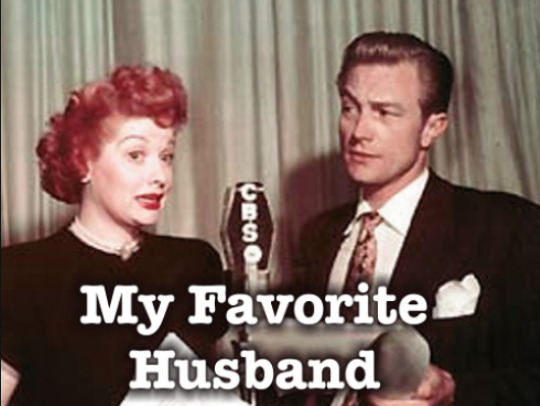
“My Favorite Husband” was based on the novels Mr. and Mrs. Cugat, the Record of a Happy Marriage (1940) and Outside Eden (1945) by Isabel Scott Rorick, which had previously been adapted into the film Are Husbands Necessary? (1942). “My Favorite Husband” was first broadcast as a one-time special on July 5, 1948. Lucille Ball and Lee Bowman played the characters of Liz and George Cugat, and a positive response to this broadcast convinced CBS to launch “My Favorite Husband” as a series. Bowman was not available Richard Denning was cast as George. On January 7, 1949, confusion with bandleader Xavier Cugat prompted a name change to Cooper. On this same episode Jell-O became its sponsor. A total of 124 episodes of the program aired from July 23, 1948 through March 31, 1951. After about ten episodes had been written, writers Fox and Davenport departed and three new writers took over – Bob Carroll, Jr., Madelyn Pugh, and head writer/producer Jess Oppenheimer. In March 1949 Gale Gordon took over the existing role of George’s boss, Rudolph Atterbury, and Bea Benaderet was added as his wife, Iris. CBS brought “My Favorite Husband” to television in 1953, starring Joan Caulfield and Barry Nelson as Liz and George Cooper. The television version ran two-and-a-half seasons, from September 1953 through December 1955, running concurrently with “I Love Lucy.” It was produced live at CBS Television City for most of its run, until switching to film for a truncated third season filmed (ironically) at Desilu and recasting Liz Cooper with Vanessa Brown.
MAIN CAST
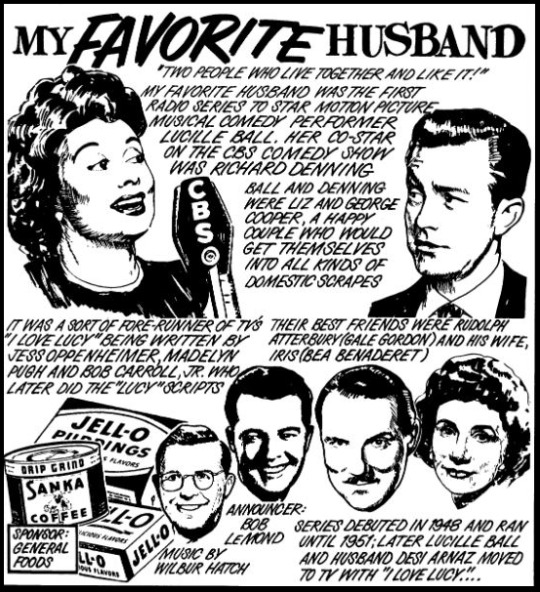
Lucille Ball (Liz Cooper) was born on August 6, 1911 in Jamestown, New York. She began her screen career in 1933 and was known in Hollywood as ‘Queen of the B’s’ due to her many appearances in ‘B’ movies. With Richard Denning, she starred in a radio program titled “My Favorite Husband” which eventually led to the creation of “I Love Lucy,” a television situation comedy in which she co-starred with her real-life husband, Latin bandleader Desi Arnaz. The program was phenomenally successful, allowing the couple to purchase what was once RKO Studios, re-naming it Desilu. When the show ended in 1960 (in an hour-long format known as “The Lucy-Desi Comedy Hour”) so did Lucy and Desi’s marriage. In 1962, hoping to keep Desilu financially solvent, Lucy returned to the sitcom format with “The Lucy Show,” which lasted six seasons. She followed that with a similar sitcom “Here’s Lucy” co-starring with her real-life children, Lucie and Desi Jr., as well as Gale Gordon, who had joined the cast of “The Lucy Show” during season two. Before her death in 1989, Lucy made one more attempt at a sitcom with “Life With Lucy,” also with Gordon.
Richard Denning (George Cooper) was born Louis Albert Heindrich Denninger Jr., in Poughkeepsie, New York. When he was 18 months old, his family moved to Los Angeles. Plans called for him to take over his father’s garment manufacturing business, but he developed an interest in acting. Denning enlisted in the US Navy during World War II. He is best known for his roles in various science fiction and horror films of the 1950s. Although he teamed with Lucille Ball on radio in “My Favorite Husband,” the two never acted together on screen. While “I Love Lucy” was on the air, he was seen on another CBS TV series, “Mr. & Mrs. North.” From 1968 to 1980 he played the Governor on “Hawaii 5-0″, his final role. He died in 1998 at age 84.
Bea Benadaret (Iris Atterbury) was considered the front-runner to be cast as Ethel Mertz but when “I Love Lucy” was ready to start production she was already playing a similar role on TV’s “The George Burns and Gracie Allen Show” so Vivian Vance was cast instead. On “I Love Lucy” she was cast as Lucy Ricardo’s spinster neighbor, Miss Lewis, in “Lucy Plays Cupid” (ILL S1;E15) in early 1952. Later, she was a success in her own show, “Petticoat Junction” as Shady Rest Hotel proprietress Kate Bradley. She starred in the series until her death in 1968.
Ruth Perrott (Katie, the Maid) was also later seen on “I Love Lucy.” She first played Mrs. Pomerantz, a member of the surprise investigating committee for the Society Matrons League in “Pioneer Women” (ILL S1;E25), as one of the member of the Wednesday Afternoon Fine Arts League in “Lucy and Ethel Buy the Same Dress” (ILL S3;E3), and also played a nurse when “Lucy Goes to the Hospital” (ILL S2;E16). She died in 1996 at the age of 96.
Bob LeMond (Announcer) also served as the announcer for the pilot episode of “I Love Lucy”. When the long-lost pilot was finally discovered in 1990, a few moments of the opening narration were damaged and lost, so LeMond – fifty years later – recreated the narration for the CBS special and subsequent DVD release.
Gale Gordon (Rudolph Atterbury, George’s boss and Iris’s husband) does not appear in this episode, although the character is mentioned.
GUEST CAST
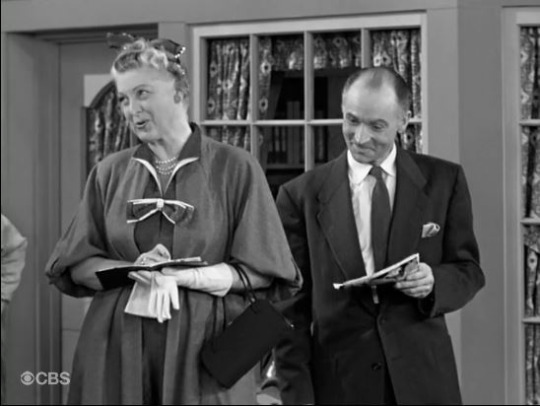
Eleanor Audley (Leaticia Cooper, George’s Mother) previously played this character in “George is Messy” on June 14, 1950. She would later play Eleanor Spalding, owner of the Westport home the Ricardos buy in “Lucy Wants To Move to the Country” (ILL S6;E15) in 1957, as well as one of the Garden Club judges in “Lucy Raises Tulips” (ILL S6;E26).
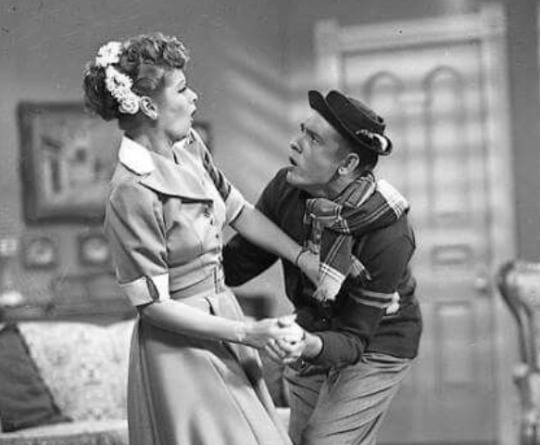
Richard Crenna (Delivery Boy) would make his television debut with Lucille Ball as Arthur Morton in “The Young Fans” (ILL S1;E20). The character is virtually a carbon copy of Walter Denton, the role he played for four years on radio’s “Our Miss Brooks” starring Eve Arden. In 1952, Desilu brought the show to television where Crenna recreated his role. He later starred in Desilu’s “The Real McCoys.” He would become one of Hollywood’s busiest actors, starring in "Vega$” and Sylvester Stallone’s Rambo films. He died in 2003.
THE EPISODE

ANNOUNCER: “In a little white two-story house located at 321 Bundy Drive in the bustling little suburb of Sheridan Falls, George Cooper is just leaving for the bank.”
Before leaving for work, George breaks the news to Liz that his mother is coming to dinner that night.
At the dinner table that evening, Mother Cooper (Eleanor Audley) is reminding her son to eat his spinach, thinking Liz is not feeding him properly. George suddenly remembers that he’s invited the Atterbury’s and some out-of-town clients to dinner on Monday night - dinner for twelve. The only problem is, Katie is going away on vacation on Sunday, so Mother Cooper suggest Liz cook the dinner herself.
Liz brags that she made the soufflé herself. Mother Cooper insists that Liz give her the recipe - right now!
LIZ: “Well, you just put all the cheese and things in a bowl. They you take a piece of ‘souff’ and put it on the top.”
Liz vows to cook dinner Monday night - all on her own. Monday morning, Liz cooks breakfast for George. The eggs are stone cold. Liz says she cooked them the night before and froze them to save time.
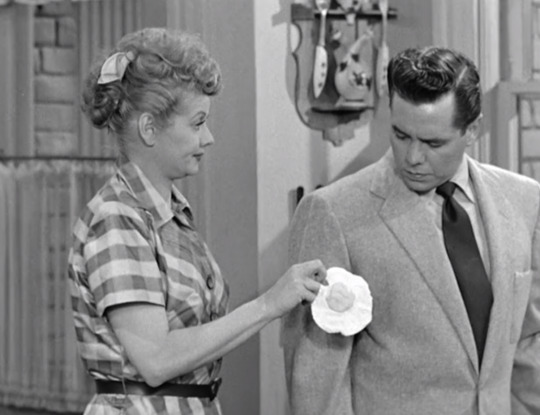
In “Lucy’s Schedule” (ILL S1;E31), to save time, Lucy prepares Ricky’s breakfast the night before and freezes it. She serves him frozen fried egg, exactly what Liz served George two years earlier!
Liz has invited Iris Atterbury over to help her cook the dinner for twelve. George leaves for work and the women repair to the kitchen to get a start on dinner. When Liz says she’s decided on chicken as the main course, Iris wonders assumes it will be broiled chicken.
LIZ (indignant): “Please! Does Oscar of the Waldorf serve broiled chicken? We are having poulet almondine.”
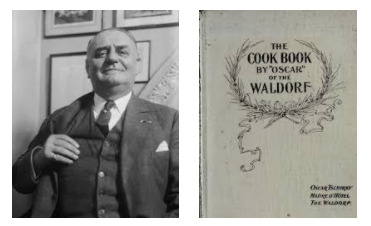
Oscar Tschirky (1866-1950) was a Swiss-American restaurateur who was maître d'hôtel of Delmonico's Restaurant and subsequently the Waldorf-Astoria Hotel in Manhattan, New York, United States. He was widely known as "Oscar of the Waldorf" and published a large cookbook. He is credited with having created the Waldorf salad, and for aiding in the popularization of the Thousand Island dressing. He died three weeks after this episode aired.
Liz realizes that she needs mushrooms but that she doesn’t have any in the house. She wonders whether she can use the mushrooms growing in the backyard. Iris points out that they may be toadstools, which are poisonous. Liz decides to use walnuts instead.
The girls peel onions for the dressing. They begin to tear-up from cutting the onions.
LIZ (tearfully): “This is the best time I’ve had in ages!” IRIS (crying): “Me too!”
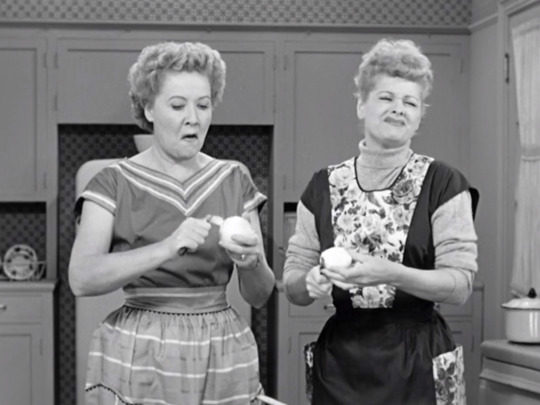
In “The Million Dollar Idea” (ILL S3;E13) in 1954, Lucy and Ethel were awash in tears when they peeled onions to make Aunt Martha’s Old Fashioned Salad Dressing.
ANNOUNCER: “As we return to the Cooper’s it’s several hours later and we find the kitchen knee deep in dirty saucepans, greasy skillets, broken eggshells, and well-thumbed cookbooks. Surveying the wreckage are Liz and Iris Atterbury.”
Iris wonders whether the chickens are ready to come out of the oven. Liz says she put them on at 9am at 600 degrees! Iris points out that they were only supposed to cook at 300 degrees.
LIZ: “I know but we have two chickens so I doubled it!” IRIS: “I never would have thought of that.”
They open the over and find their two chickens have burned to a crisp and resemble “two little lumps of charcoal with legs and wings”! Just then, Mother Cooper arrives.
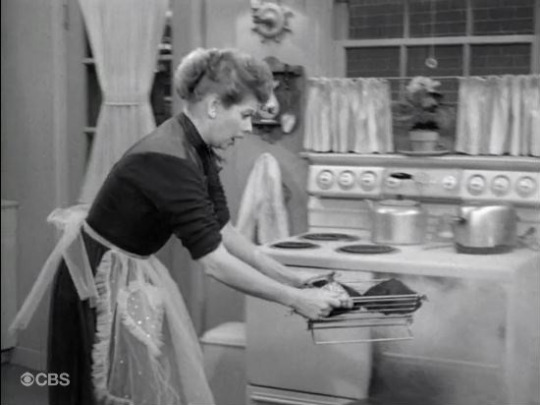
Lucy burned two chickens in “The Matchmaker” (ILL S4;E4) when preparing dinner for Sam (the spider) and Dorothy (the fly) a dating couple Lucy hopes to lure into matrimonial bliss.
Liz and Iris don’t tell Mother Cooper about the burned chickens. Chicken almandine is her favorite dish. She advises Liz on her cooking technique:
MOTHER: “You just keep your eye on them until they’re a nice crinkly brown.” IRIS: “How about a nice crusty black?”
Mother Cooper discovers that Liz has burned the dinner. They trade insults and Mother storms out in a huff. Iris promises to help Liz cook a new dinner, but first she has to go to the beauty parlor to have her hair done.
When Iris gets home from the beauty parlor she phones Liz to see how the dinner is going. Liz is dazed and confused.
LIZ: “Iris, you are talking to a woman who’s gone through eight chickens today.”
Liz reports that the pressure cooker exploded and the chickens are still on the ceiling.
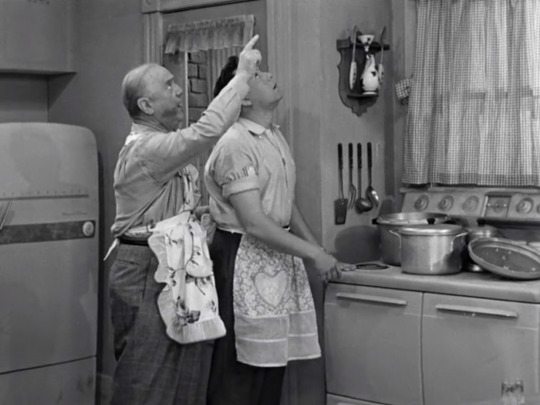
When Lucy and Ethel are working at the chocolate factory in “Job Switching” (ILL S2;E1), Ricky and Fred are cooking dinner at home. Ricky puts two chickens in the pressure cooker, which explodes and strands the birds on the ceiling!
Liz’s fifth and sixth birds were accidentally thrown in the garbage disposal. The seventh and eighth birds arrived from the butcher still alive! Iris asks Liz if she has cooked them yet.
LIZ: “Cook ‘em? I can’t even catch ‘em! When last seen, seven and eight were going east on Bundy Drive.” IRIS: “You poor thing! Eight chickens and nothing to show for it!” LIZ: “Oh, yes I have. Before she left seven laid an egg on the kitchen table.”
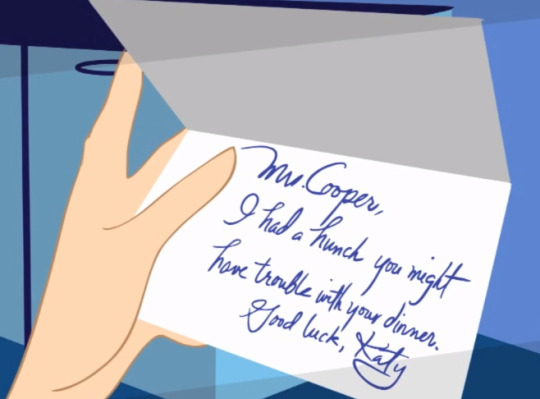
Iris tells Liz everything will be alright. Just then, a delivery boy from Johnson’s Catering Service (Dick Crenna) arrives at the Cooper’s back door with a meal for twelve: Roast prime ribs of beef, green beans, potatoes, and Yorkshire pudding. The meal was sent by Katie!
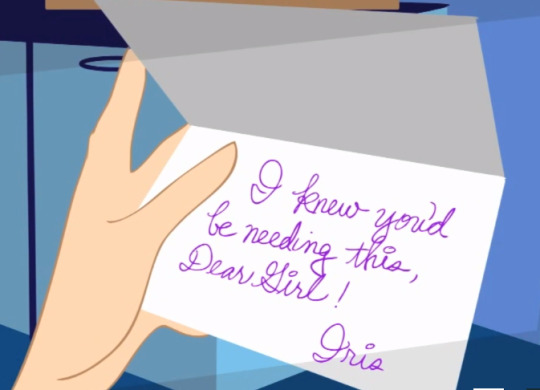
Just as she is about to call Katie to thank her, the Delivery Boy returns with another catered dinner: Lobster Thermidor with French fries and asparagus. This meal was sent over by Iris!
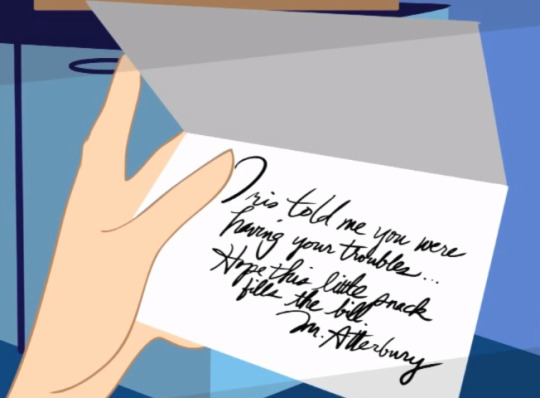
The Delivery Boy returns yet a third time! This time with Pheasant under Glass sent by Mr. Atterbury! Liz tips the boy with a bowl of Yorkshire pudding.
Oops! Yorkshire pudding is not served in a bowl. It is not a pudding in the American sense, but similar to pop-overs, designed to sop up the drippings and gravy when served with a roast beef.
The phone rings and it is Mother Cooper telling Liz that she has made a dinner for twelve and will bring it over. Liz says thanks but no thanks, and invites her to make the dinner party 13.
The phone rings once again - it is George. He has called to tell Liz that he has made a mistake. The dinner isn’t until next Monday night!
LIZ: “Oh, no!”
Announcer Bob LeMond reminds listeners that Lucille Ball can currently be seen in The Fuller Brush Girl and that they can read about her in the current issue of Pageant Magazine.
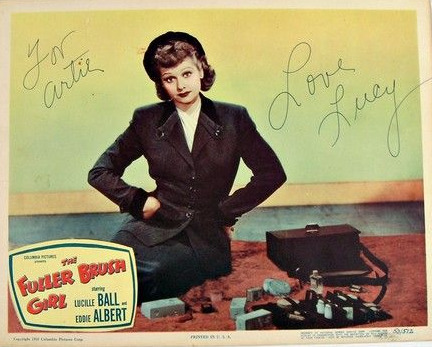
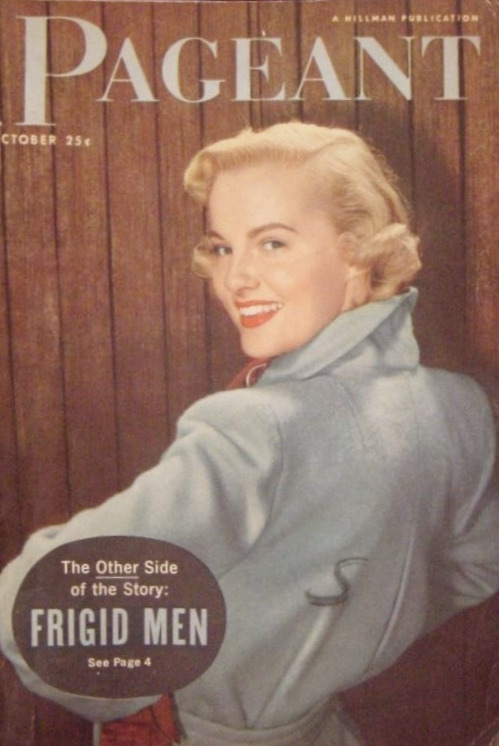
#Lucille Ball#My Favorite Husband#1950#Radio#Richard Denning#Bea Benadaret#Richard Crenna#Eleanor Audley#Bob LeMond#Ruth Perrott#I Love Lucy#The Fuller Brush Girl#Pageant Magazine#Oscar of the Waldorf#Oscar Tschirky
8 notes
·
View notes
Text
THE HEALTH FARM
May 7, 1950
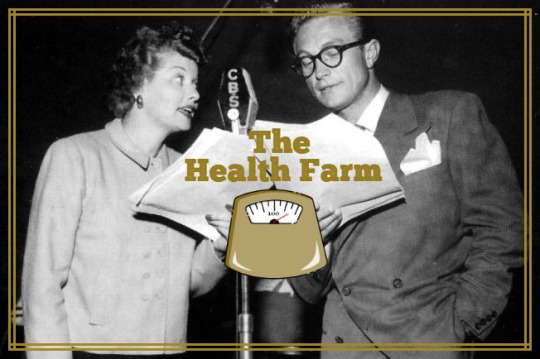
"The Health Farm” is episode #87 of the radio series MY FAVORITE HUSBAND broadcast on May 7, 1950.
Synopsis ~ Liz and Iris are fed up with their husbands taking them for granted, so they check in to a fat farm.

This episode features elements that later went into the “I Love Lucy” episodes “The Diet” (ILL S1;E3 ~ October 29, 1951) and “The Charm School” (ILL S3;E15 ~ January 25, 1954). Lucy Carmichael and the Countess Frambois went to a fat farm run by Mr. Mooney in “Lucy and the Countess Lose Weight” (TLS S3;E21) on February 15, 1965.

“My Favorite Husband” was based on the novels Mr. and Mrs. Cugat, the Record of a Happy Marriage (1940) and Outside Eden (1945) by Isabel Scott Rorick, which had previously been adapted into the film Are Husbands Necessary? (1942). “My Favorite Husband” was first broadcast as a one-time special on July 5, 1948. Lucille Ball and Lee Bowman played the characters of Liz and George Cugat, and a positive response to this broadcast convinced CBS to launch “My Favorite Husband” as a series. Bowman was not available Richard Denning was cast as George. On January 7, 1949, confusion with bandleader Xavier Cugat prompted a name change to Cooper. On this same episode Jell-O became its sponsor. A total of 124 episodes of the program aired from July 23, 1948 through March 31, 1951. After about ten episodes had been written, writers Fox and Davenport departed and three new writers took over – Bob Carroll, Jr., Madelyn Pugh, and head writer/producer Jess Oppenheimer. In March 1949 Gale Gordon took over the existing role of George’s boss, Rudolph Atterbury, and Bea Benadaret was added as his wife, Iris. CBS brought “My Favorite Husband” to television in 1953, starring Joan Caulfield and Barry Nelson as Liz and George Cooper. The television version ran two-and-a-half seasons, from September 1953 through December 1955, running concurrently with “I Love Lucy.” It was produced live at CBS Television City for most of its run, until switching to film for a truncated third season filmed (ironically) at Desilu and recasting Liz Cooper with Vanessa Brown.
MAIN CAST

Lucille Ball (Liz Cooper) was born on August 6, 1911 in Jamestown, New York. She began her screen career in 1933 and was known in Hollywood as ‘Queen of the B’s’ due to her many appearances in ‘B’ movies. With Richard Denning, she starred in a radio program titled “My Favorite Husband” which eventually led to the creation of “I Love Lucy,” a television situation comedy in which she co-starred with her real-life husband, Latin bandleader Desi Arnaz. The program was phenomenally successful, allowing the couple to purchase what was once RKO Studios, re-naming it Desilu. When the show ended in 1960 (in an hour-long format known as “The Lucy-Desi Comedy Hour”) so did Lucy and Desi’s marriage. In 1962, hoping to keep Desilu financially solvent, Lucy returned to the sitcom format with “The Lucy Show,” which lasted six seasons. She followed that with a similar sitcom “Here’s Lucy” co-starring with her real-life children, Lucie and Desi Jr., as well as Gale Gordon, who had joined the cast of “The Lucy Show” during season two. Before her death in 1989, Lucy made one more attempt at a sitcom with “Life With Lucy,” also with Gordon.
Richard Denning (George Cooper) was born Louis Albert Heindrich Denninger Jr., in Poughkeepsie, New York. When he was 18 months old, his family moved to Los Angeles. Plans called for him to take over his father’s garment manufacturing business, but he developed an interest in acting. Denning enlisted in the US Navy during World War II. He is best known for his roles in various science fiction and horror films of the 1950s. Although he teamed with Lucille Ball on radio in “My Favorite Husband,” the two never acted together on screen. While “I Love Lucy” was on the air, he was seen on another CBS TV series, “Mr. & Mrs. North.” From 1968 to 1980 he played the Governor on “Hawaii 5-0″, his final role. He died in 1998 at age 84.
Gale Gordon (Rudolph Atterbury) had worked with Lucille Ball on “The Wonder Show” on radio in 1938. One of the front-runners to play Fred Mertz on “I Love Lucy,” he eventually played Alvin Littlefield, owner of the Tropicana, during two episodes in 1952. After playing a Judge in an episode of “The Lucy-Desi Comedy Hour” in 1958, he would re-team with Lucy for all of her subsequent series’: as Theodore J. Mooney in ”The Lucy Show”; as Harrison Otis Carter in “Here’s Lucy”; and as Curtis McGibbon on “Life with Lucy.” Gordon died in 1995 at the age of 89.
Bea Benadaret (Iris Atterbury) was considered the front-runner to be cast as Ethel Mertz but when “I Love Lucy” was ready to start production she was already playing a similar role on TV’s “The George Burns and Gracie Allen Show” so Vivian Vance was cast instead. On “I Love Lucy” she was cast as Lucy Ricardo’s spinster neighbor, Miss Lewis, in “Lucy Plays Cupid” (ILL S1;E15) in early 1952. Later, she was a success in her own show, “Petticoat Junction” as Shady Rest Hotel proprietress Kate Bradley. She starred in the series until her death in 1968.
Ruth Perrott (Katie, the Maid) does not appear in this episode.
Bob LeMond (Announcer) also served as the announcer for the pilot episode of “I Love Lucy”. When the long-lost pilot was finally discovered in 1990, a few moments of the opening narration were damaged and lost, so LeMond – fifty years later – recreated the narration for the CBS special and subsequent DVD release.
GUEST CAST
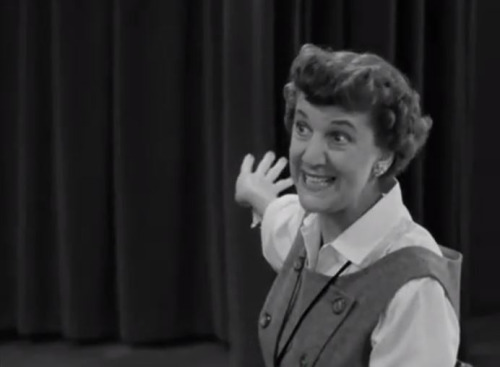
Elvia Allman (Mrs. Fataway) was born on September 19, 1904 in Enochville, North Carolina. She started her performing career on radio in the 1920s, as both a storyteller and singer. This led to work voicing cartoon characters for Warner Brothers. Simultaneously, she was pursuing stage acting, appearing at the Pasadena Playhouse. Allman made her film debut as an actress in 1940’s The Road to Singapore as a homely woman who pursues Bob Hope. Allman played the strident forewoman of Kramer’s Kandy Kitchen in “Job Switching” (ILL S2;E1). She would return to the show as one of Minnie Finch’s neighbors in “Fan Magazine” (ILL S3;E17) and as reporter Nancy Graham in “The Homecoming” (ILL S5;E6). She made two appearances each on The Lucy–Desi Comedy Hour“ and ”The Lucy Show.“
EPISODE
ANNOUNCER: “As we look in on the Coopers today, we find George in his office at the bank. Suddenly, the door bursts open and in strides Mr. Atterbury, his boss.”
Mr. Atterbury is upset that somehow Liz’s girdle got entered on his balance sheet. George is worried about Liz. She has been buying lots of new clothes lately. Mr. Atterbury tells him the trick of combating new clothing bought by wives. When they try it on and ask “How do you like my new dress?” you say “What new dress?” They immediately return it as looking just like her old one!

Liz and Iris are out shopping. Liz shockingly says she’s not going to buy anything today. She is doing it because of George’s concern about her budget.
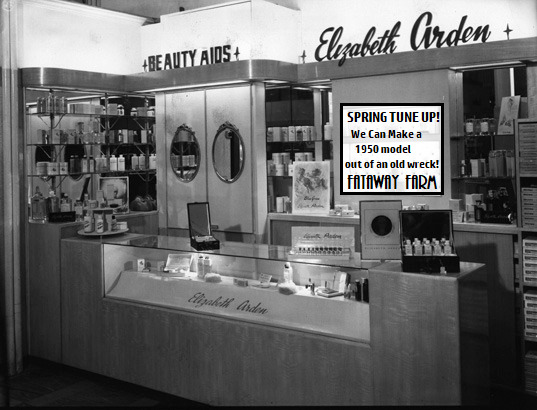
They see a sign: GET YOUR SPRING TUNE-UP! WE CAN MAKE A 1950 MODEL OUT OF AN OLD WRECK! SPEND 11 GLORIOUS DAYS AT FATAWAY FARM
Liz sees some ‘dirty words’ that tempt her: “Gigantic Clearance Sale!” Liz attempts to turn her back away from temptation, but when somebody is looking at the same dress she likes - she give in to temptation.
Liz and Iris arrive home with their shopping. They go to the bedroom to put Liz’s new things away: a dress, a bag, and shoes. She now has to think about what lie to tell George before the bill arrives in a month. Iris tells her that George won’t notice if she wears the dress because husbands only notice OTHER women!
IRIS: “Every time I get a new dress I show it to Rudolph and he says ‘What new dress?’ and as long as he doesn’t know it’s new, I keep it!”
Iris dares her to put the new dress on and see if George notices. George comes home and Liz takes the dare. Liz parades in front of George in the new dress. Just as Iris said, George doesn’t notice anything. She finally breaks down and asks him about her new dress.
GEORGE: “What new dress? I’ve seen it a hundred times!”
Liz is indignant that George takes her for granted and bursts into tears.
ANNOUNCER: “As we return to the Coopers, we find Liz and Iris Atterbury down at the corner drugstore. Iris is trying to console Liz, who believes George takes her for granted.”

LIZ: “What are you supposed to do when you think that you’re the apple of your husband’s eye and find out you’re the core?” IRIS: “You’re not alone, Liz! The world is full of single apples and married cores. It’s part of living.”
Iris tells Liz that she’s expecting her husband to act like a fiancé! Liz realizes she’s let herself go. She’s taken herself for granted. They remember the ad in the beauty shop and decide to go for the free tune-up - if not the whole overhaul! They decide to tell their husband’s that they are staying at Marge Van Tassel’s country place.
At Fataway Farms, they arrive at the office. Mrs. Fataway (Elvia Allman) greets them, and outlines their plan. They get scared of their fierce founder, but they are locked in!
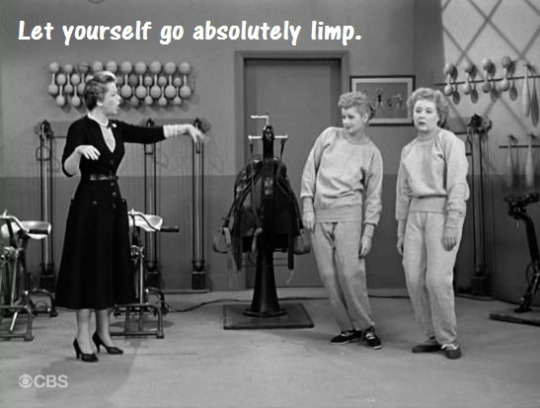
Mrs. Fataway leads Iris and Liz in exercises, which they struggle with mightily. Next Liz and Iris try out the steam cabinets.

LIZ: “If they don’t come soon, they’ll have to pick me up with a blotter.”
Liz is a limp rag when Mrs. Fataway finally opens the cabinets. She announces a two-mile hike!
LIZ: “Keen dipped in pickle juice.”
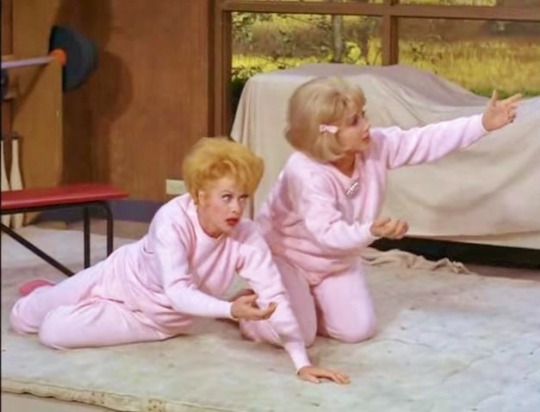
On their hike they finally reach their destination. They have the option to ride back or march back. Liz is to weak to even express an opinion, and ends up walking back.
After 11 days, Liz and Iris arrive home, feeling rejuvenated and revitalized! Their husbands greet them with affection.
George notices that Liz looks thin and calls her a plucked chicken. Liz breaks down in tears.
GEORGE: “I didn’t want you beautiful. I want you just the way you were.”
Liz is relieved and starts to gorge herself with food! Iris is just about to join in, when Rudolph stops her!
MR. ATTERBURY: “I like you just as you are now!”
End of Episode

In the live Jell-O commercial tag, Lucille plays a siren from ancient mythology and Bob LeMond a sailor being lured toward the rocks.
Lucille’s first line as a siren is to imitate a police siren. She then lapses into a chirpy, pinched nosed voice.
LUCILLE / SIREN: “Oh, sailor! Oh, sailor boy! I have Jell-O tapioca pudding!”
He asks her if she has Jell-O orange coconut tapioca.
LUCILLE / SIREN: “A wonderful blend of refreshing orange and tropical coconuts?” BOB / SAILOR: “Yes! Do you?” LUCILLE / SIREN: “No. I just wanted to see what happened.”
The siren lures him to the rocks. The sound effects end with a motorboat crashing with a big boom!
ANNOUNCER: “Watch for Lucille Ball in today’s issue of Parade.”
#My Favorite Husband#The Health Farm#Lucille Ball#Richard Denning#Bea Benaderet#Gale Gordon#Bob LeMond#Jello#Elvia Allman#Health Farm#Fat Farm#I Love Lucy#The Lucy Show#CBS#Radio#1950
1 note
·
View note
Text
ELVIA ALLMAN
September 19, 1904

Elvia Beatrice Allman was born on September 19, 1904 in Enochville, North Carolina. She started her performing career on radio in the 1920s, as both a storyteller and singer. This led to work voicing cartoon characters for Warner Brothers. Simultaneously, she was pursuing stage acting, appearing at the Pasadena Playhouse.
Allman made her film debut as an actress in 1940's The Road to Singapore as a homely woman who pursues Bob Hope.

On radio, she worked with Lucille Ball on “My Favorite Husband”.
Her first TV credit came in August 1951, in an episode of “Hollywood Theatre Time” written by “I Love Lucy” scribes Bob Carroll and Madelyn Pugh Davis. This undoubtedly led to her first encounter with Lucille Ball.

Allman’s first episode of “I Love Lucy” is also one of the most memorable in TV history: “Job Switching” (ILL S2;E1) in September 1952. She played the strident foreman of Kramer’s Candy Kitchen.

This portrayal has been seen numerous times across various media, and often imitated, but perhaps none more brilliantly than on “Will & Grace” where Lucie Arnaz played the role originated by Allman.
“I’m thrilled to be invited to the party and will do my best to honor the memory of Elvia Allman’s iconic performance.” ~ Lucie Arnaz

NEIGHBOR: “Do you wanna see Minnie or don’t ya?”
Allman returned to the show as one of Minnie Finch’s neighbors in “Fan Magazine Interview” (ILL S3;E17) in 1954, quite a change of pace.

NANCY GRAHAM: “When did you first meet...himmm?”
Changing gears once again she played prim magazine reporter Nancy Graham in “The Homecoming” (ILL S5;E6) in 1955. The character is probably a tribute to Sheilah Graham, who was an English-born Hollywood journalist.

Graham suggests that her article will be titled “NOW I AM HIS SLAVE” by LUCY RICARDO, a title that would raise more than a few eyebrows, even in 1955!

She made two appearances on “The Lucy–Desi Comedy Hour“ - first as Ida Thompson, Westfield’s PTA director who is enamored of Tallulah Bankhead in “The Celebrity Next Door” (LDCH S1;E2) in December 1957. The character is likely named in honor of Maury Thompson, who was the show’s long-time camera coordinator.

She was Milton Berle’s over-protective secretary when “Milton Berle Hides Out at the Ricardos” (LDCH S3;E1) in 1959.

Allman would also be seen on two episodes of “The Lucy Show.” First as a customer shopping for a new hat when Lucy takes a job at Stacey’s Department Store in “Lucy Bags a Bargain” (TLS S4;E17) in 1966. Allman flips her wig when Lucy bungles the sale!

Her second, and final Lucycom appearance, was in “Lucy The Babysitter” (TLS S5;E16) in 1967. Allman finally gets to use her own name to play the manager of an employment agency visited by Mrs. Carmichael. Coincidentally, the name of the business is the Unique Employment Agency, which will also be the name of the Employment Agency on “Here’s Lucy.” This pretty much brings things full circle for Allman, whose first episode of “I Love Lucy” featured the Acme Employment Agency, the agency that places Lucy and Ethel at Kramer’s Candy Kitchen!

Allman’s final screen appearance with Lucille Ball reunited her with Bob Hope: “Bringing Back Vaudeville” on November 16, 1971 on NBC.

Back in 1952, the same year Allman did her first “I Love Lucy” episode, she was a recurring character on NBC’s answer to “Lucy”, “I Married Joan” which - like “Lucy” - also filmed at General Service Studios. Consequently, the two shows shared many performers. Allman played Aunt Vera for six episodes during season one.

In May 1953, Allman did a single episode of “Our Miss Brooks,” filmed by Desilu. She appeared opposite Eve Arden, Gale Gordon, Richard Crenna, and Gloria McMillan, all of who appeared on “I Love Lucy.”

In October 1954, she played a maid on the Desilu filmed “Make Room for Daddy”. In 1958, to symbolize the show’s move to CBS, the Williams family moved into the Ricardo home in Westport. In return, Lucy and Desi guest-starred on “The Danny Thomas Show” as the Ricardos.

Also in 1954, Allman started appearing on Desilu’s “December Bride,” doing six episodes until 1959, mostly playing Sara Selkirk. In 1957, Executive Producer Desi Arnaz appeared as himself. In 1960 she was featured on the very first episode of the sequel series, “Pete and Gladys” and did another episode in 1962.

In October 1958, she did a day on Desilu’s “The Ann Sothern Show.” In November 1959,Lucille Ball played Lucy Ricardo on the series’ season two premiere.

In January 1961, Allman played Henrietta Swanson on “The Andy Griffith Show” filmed on the Desilu backlot.

A few months later, she did a day on “The Real McCoys”, also filmed on the Desilu backlot.

In June 1964, Allman did an installment of “Vacation Playhouse” - a Desilu anthology series of possible pilots.

In 1963 and 1965, Allman did episodes of “The Dick Van Dyke Show” filmed at Desilu Studios. The second featured Amzie Strickland, who also appeared with her in “Lucy Bags a Bargain” (TLS S4;E17).

Allman has the distinction of appearing in all three of CBS’s inter-connected rural sitcoms (albeit as different characters): “The Beverly Hillbillies” (as Elverna Bradshaw); “Petticoat Junction” (as Selma Plout); and “Green Acres” (as Cora Watson).
Her final screen appearance was on a 1989 episode of “Murder She Wrote” starring Angela Lansbury.
Her first husband, Wesley B. Tourtellotte, was a musician whom she married in 1930. The marriage was short-lived and produced one child. Her second was Charles Pyle, who was often called Cash and Carry Pyle, an Illinois theater owner and sports agent. They married in 1937 but he died of a heart attack two years later. Her third and last marriage, to Jerome Bayler, lasted 33 years until his death in 1978.

Allman died on March 6, 1992, aged 87.
7 notes
·
View notes
Text
LIZ LEARNS TO DRIVE
November 13, 1948

“Liz Learns To Drive” (aka “Liz's Driving License” and “Liz Learns to Drive”) is episode #16 of the radio series MY FAVORITE HUSBAND broadcast on November 13, 1948.
Synopsis ~ George teaches Liz to drive and she immediately gets in an accident. Through a communications mix-up, George thinks Liz has intentionally run over George's high school sweetheart, Myra Ponsenby!
Note: This episode was aired before the characters names were changed from Cugat to Cooper. It was also before Jell-O came aboard to sponsor the show and before the regular cast featured Bea Benadaret and Gale Gordon as the Atterburys.
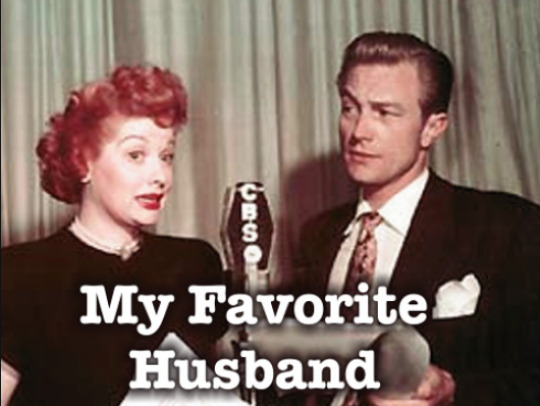
“My Favorite Husband” was based on the novels Mr. and Mrs. Cugat, the Record of a Happy Marriage (1940) and Outside Eden (1945) by Isabel Scott Rorick, which had previously been adapted into the film Are Husbands Necessary? (1942). “My Favorite Husband” was first broadcast as a one-time special on July 5, 1948. Lucille Ball and Lee Bowman played the characters of Liz and George Cugat, and a positive response to this broadcast convinced CBS to launch “My Favorite Husband” as a series. Bowman was not available Richard Denning was cast as George. On January 7, 1949, confusion with bandleader Xavier Cugat prompted a name change to Cooper. On this same episode Jell-O became its sponsor. A total of 124 episodes of the program aired from July 23, 1948 through March 31, 1951. After about ten episodes had been written, writers Fox and Davenport departed and three new writers took over – Bob Carroll, Jr., Madelyn Pugh, and head writer/producer Jess Oppenheimer. In March 1949 Gale Gordon took over the existing role of George’s boss, Rudolph Atterbury, and Bea Benaderet was added as his wife, Iris. CBS brought “My Favorite Husband” to television in 1953, starring Joan Caulfield and Barry Nelson as Liz and George Cooper. The television version ran two-and-a-half seasons, from September 1953 through December 1955, running concurrently with “I Love Lucy.” It was produced live at CBS Television City for most of its run, until switching to film for a truncated third season filmed (ironically) at Desilu and recasting Liz Cooper with Vanessa Brown.
MAIN CAST
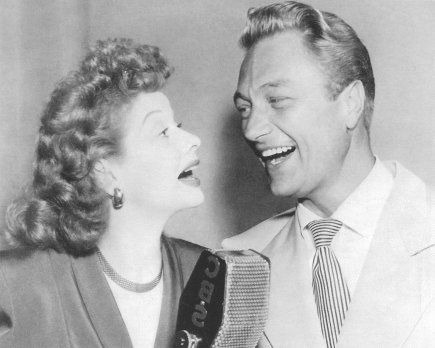
Lucille Ball (Liz Cugat) was born on August 6, 1911 in Jamestown, New York. She began her screen career in 1933 and was known in Hollywood as ‘Queen of the B’s’ due to her many appearances in ‘B’ movies. “My Favorite Husband” eventually led to the creation of “I Love Lucy,” a television situation comedy in which she co-starred with her real-life husband, Latin bandleader Desi Arnaz. The program was phenomenally successful, allowing the couple to purchase what was once RKO Studios, re-naming it Desilu. When the show ended in 1960 (in an hour-long format known as “The Lucy-Desi Comedy Hour”) so did Lucy and Desi’s marriage. In 1962, hoping to keep Desilu financially solvent, Lucy returned to the sitcom format with “The Lucy Show,” which lasted six seasons. She followed that with a similar sitcom “Here’s Lucy” co-starring with her real-life children, Lucie and Desi Jr., as well as Gale Gordon, who had joined the cast of “The Lucy Show” during season two. Before her death in 1989, Lucy made one more attempt at a sitcom with “Life With Lucy,” also with Gordon.
Richard Denning (George Cugat) was born Louis Albert Heindrich Denninger Jr., in Poughkeepsie, New York. When he was 18 months old, his family moved to Los Angeles. Plans called for him to take over his father’s garment manufacturing business, but he developed an interest in acting. Denning enlisted in the US Navy during World War II. He is best known for his roles in various science fiction and horror films of the 1950s. Although he teamed with Lucille Ball on radio in “My Favorite Husband,” the two never acted together on screen. While “I Love Lucy” was on the air, he was seen on another CBS TV series, “Mr. & Mrs. North.” From 1968 to 1980 he played the Governor on “Hawaii 5-0″, his final role. He died in 1998 at age 84.
Ruth Perrott (Katie, the Maid) was also later seen on “I Love Lucy.” She first played Mrs. Pomerantz, a member of the surprise investigating committee for the Society Matrons League in “Pioneer Women” (ILL S1;E25), as one of the member of the Wednesday Afternoon Fine Arts League in “Lucy and Ethel Buy the Same Dress” (ILL S3;E3), and also played a nurse when “Lucy Goes to the Hospital” (ILL S2;E16). She died in 1996 at the age of 96.
Bob LeMond (Announcer) also served as the announcer for the pilot episode of “I Love Lucy”. When the long-lost pilot was finally discovered in 1990, a few moments of the opening narration were damaged and lost, so LeMond – fifty years later – recreated the narration for the CBS special and subsequent DVD release.
GUEST CAST
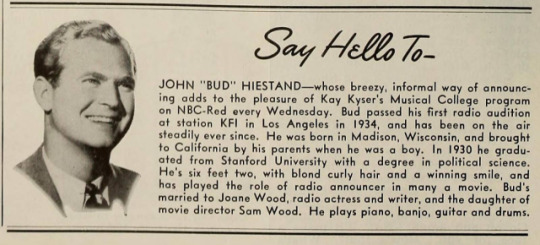
John Hiestand (Cory Cartwright) served as the announcer for the radio show “Let George Do It” from 1946 to 1950. In 1955 he did an episode of “Our Miss Brooks” opposite Gale Gordon.
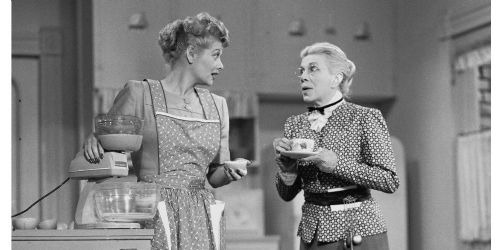
Bea Benadaret (Woman Driver) was considered the front-runner to be cast as Ethel Mertz but when “I Love Lucy” was ready to start production she was already playing a similar role on TV’s “The George Burns and Gracie Allen Show” so Vivian Vance was cast instead. On “I Love Lucy” she was cast as Lucy Ricardo’s spinster neighbor, Miss Lewis, in “Lucy Plays Cupid” (ILL S1;E15) in early 1952. Later, she was a success in her own show, “Petticoat Junction” as Shady Rest Hotel proprietress Kate Bradley. She starred in the series until her death in 1968.
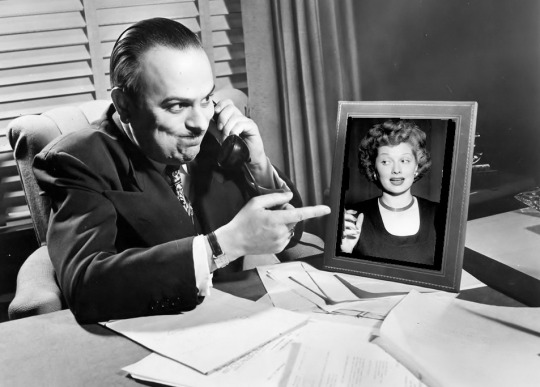
Frank Nelson (Officer Frank Nelson) was born on May 6, 1911 (three months before Lucille Ball) in Colorado Springs, Colorado. He started working as a radio announcer at the age of 15. He later appeared on such popular radio shows as “The Great Gildersleeve,” “Burns and Allen,” and “Fibber McGee & Molly”. Aside from Lucille Ball, Nelson is perhaps most associated with Jack Benny and was a fifteen-year regular on his radio and television programs. His trademark was playing clerks and other working stiffs, suddenly turning to Benny with a drawn out “Yeeeeeeeeees?” Nelson appeared in 11 episodes of “I Love Lucy”, including three as quiz master Freddy Fillmore, and two as Ralph Ramsey, plus appearance on “The Lucy-Desi Comedy Hour” - making him the only actor to play two different recurring roles on “I Love Lucy.” Nelson returned to the role of the frazzled Train Conductor for an episode of “The Lucy Show” in 1963. This marks his final appearance on a Lucille Ball sitcom.
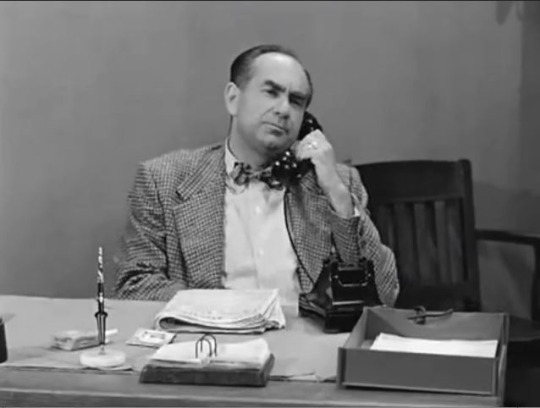
Herb Vigran (Sergeant Martin Lewis, Homicide Squad) made several appearances on “My Favorite Husband.” He would later play Jule, Ricky’s music union agent on two episodes of “I Love Lucy”. He would go on to play Joe (and Mrs. Trumbull’s nephew), the washing machine repairman in “Never Do Business With Friends” (S2;E31) and Al Sparks, the publicity man who hires Lucy and Ethel to play Martians on top of the Empire State Building in “Lucy is Envious” (S3;E23). Of his 350 screen roles, he also made six appearances on “The Lucy Show.”
The name Martin Lewis may be a tribute to the comedy team of Dean Martin and Jerry Lewis, who first performed together in 1946, and went their separate ways ten years later.
THE EPISODE
ANNOUNCER: “It is morning, and Katie the maid has just put breakfast on the table and Liz and George are sitting down to it.”
George is reluctant to read the paper at the table after Liz’s previous chastisement about ignoring her at breakfast. This time, she encourages him to pick up the newspaper and when he does, she has torn a hole through the center so she can see him and he can read the news!
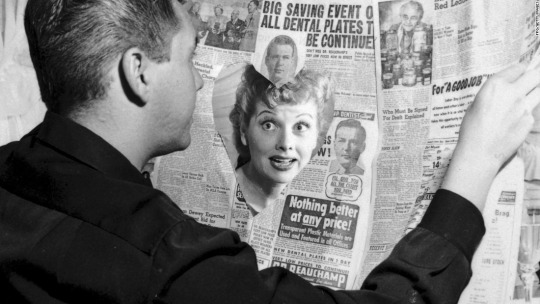
Lucy Ricardo also had the same complaint about Ricky on “I Love Lucy”!
LIZ: “I’m looking at you through an automobile ad. The new Nash has blue eyes for headlights. And your ears look like both doors are wide open.”
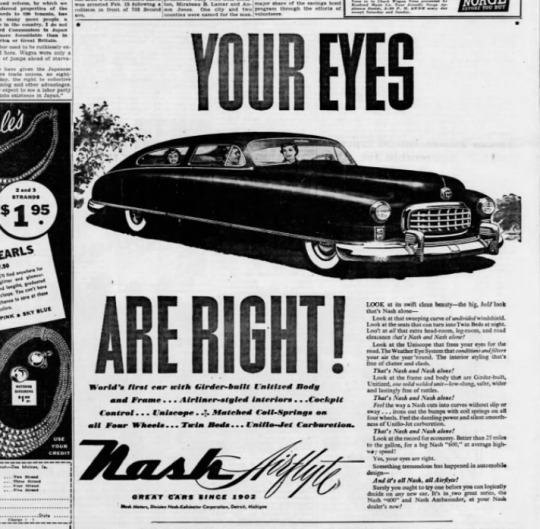
Nash Motors Company was an American automobile manufacturer based in Kenosha, Wisconsin, from 1916 to 1957. In 1938 Nash debuted the heating and ventilation system which is still used today. The aerodynamic 1949 Nash Airflyte was the first car of an advanced design introduced by the company after the war. Nash went out of business in February 1954.
Katie says she had the same problem with her first husband, Clarence. As a last resort, she set his newspaper on fire!
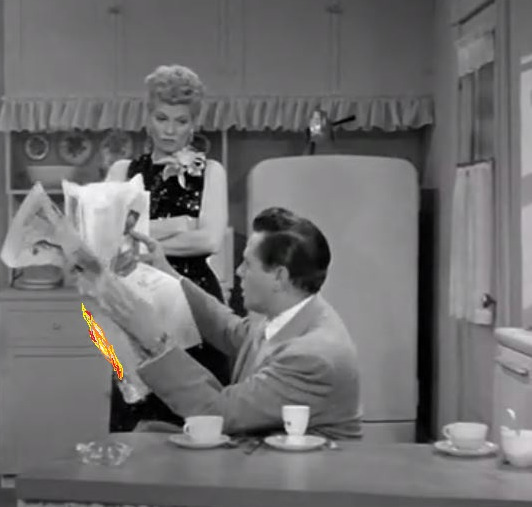
In “Be A Pal” (ILL S1;E2), Lucy also tries setting fire to the newspaper to get her husband’s attention! Considering all the trouble Desi had to assure the studio audience’s safety for the Los Angels Fire Department, it is amazing this stunt was allowed!
Through his ‘holy’ newspaper, George reads about his old college girlfriend, Myra Ponsenby. Liz is unenthusiastic.
LIZ: “What’s new in Lower Slobbovia?”
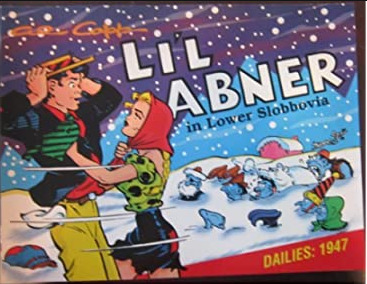
In “First Stop” (ILL S4;E14) Fred Mertz calls One Oak Cabins “Lower Slobbovia,” which is a term first used in 1946 by Al Capp in his comic strip "Li'l Abner” to describe a place that was unenlightened and socially backward.
Liz is clearly jealous and wishes Myra would “drop dead” claiming there isn’t room enough for the both of them in town. George says the article claims she is driving into town in her new imported car called a Zebra [a fictional car].
LIZ: “I’m glad she’s got a car. It was dangerous riding around on that broomstick.”
Myra is married to Mr. Minky the peanut king, who Liz insists she married for his money. Tired of hearing about Myra, Liz begs George for another driving lesson. The last time he gave her a lesson she drove their Hudson into someone’s kitchen!
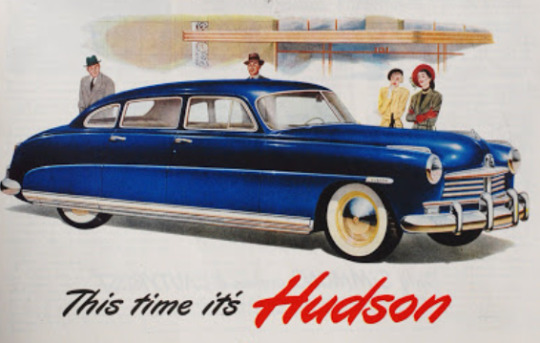
The Hudson Motor Car Company made automobiles in Detroit, Michigan from 1909 to 1954. In 1954, Hudson merged with Nash-Kelvinator to form American Motors Corporation (AMC). The Hudson name was discontinued in 1957.
George gives in and promises to give her a lesson on the back roads after work. When he gets home, she tells him she practiced before he got there, but forgot to open the garage door! Liz finally finds the starter (after trying the cigarette lighter and the radio). Then she has trouble finding the clutch. George is foaming at the mouth in anxiety.
Liz finally gets the car on the road - but the wrong side! They nearly have a collision! George gets frustrated and Liz dissolves into tears.
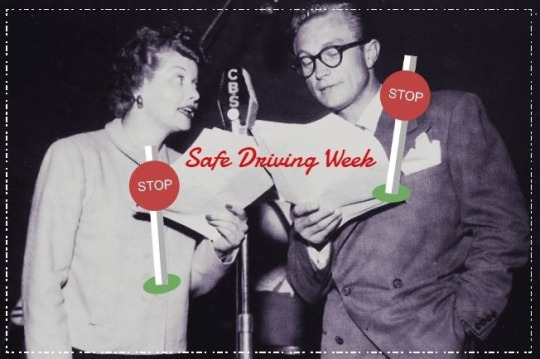
Much of the driving lesson dialogue and situations were recycled in the episode “Safe Driving Week” in October 1950. In it, George is elected town Safety Chairman just when Liz creates havoc on the roads.
Later, Cory Cartwright volunteers to help Liz pass her driving test. He wishes her luck, as she goes into the police station to get her driver’s license.
NELSON: “Name?” LIZ: “Elizabeth Cugat.” NELSON: “Address?” LIZ: “321 Bundy.” NELSON: “Race?” LIZ: “Of course not! I don’t even have a driver’s license!”
After much rhetorical to-ing and fro-ing, he takes her fingerprints and gives her the eye test:
NELSON: “Read the letters on the wall over there.” LIZ: “M-E-N.”
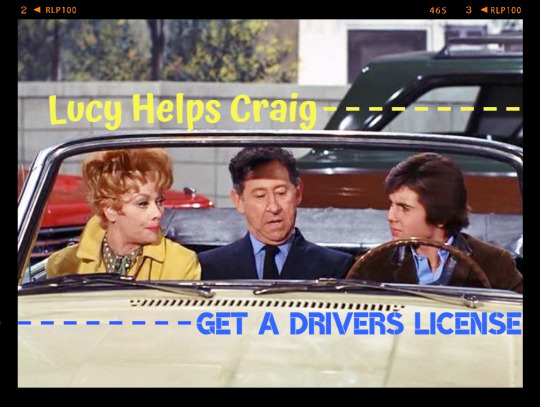
The eye test and fingerprinting that Liz undergoes are repeated when Lucy Carter helps her son Craig get a license in a 1969 episode of “Here’s Lucy.”
Somehow Liz passes the driving test and gets her license. Naturally she gets in an accident on the way home with Cory. The car is a wreck, but they are okay. The other driver is a woman (Bea Benadaret) who says she will call her lawyer and the police.
Liz doesn’t know what she will say to George about the damage to the car. Cory agrees to help her get it fixed before George finds out.

When “Lucy Learns To Drive” (ILL S4;E12) in 1955, she also has an accident after her first lesson. Like Liz, she has to come up with a story so that her favorite husband doesn’t get angry!
When Liz finally gets home, George tells her that Myra Ponsenby has been reported missing. Liz couldn’t care less, but George wants to know why she’s so late home and is acting so peculiar. The phone rings and George eavesdrops on her conversation about the car. Not knowing to whom or what she’s talking about, George believes that his wife has done away with Myra!
LIZ (on the phone): “You know how George feels about that old wreck. That wasn’t the first time she’d been hit. Did you see all those dents in her trunk? And her rear bumper was in pretty bad shape, too. Wasn’t it awful? I thought she’d never stop yelling. And all I did was hit her with the front wheels.”
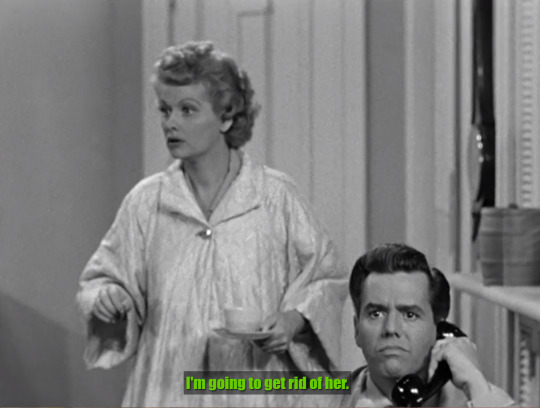
An overheard telephone conversation on the very first filmed “I Love Lucy” episode in 1951 convinces Lucy that Ricky is going to murder her! Of course, Ricky is merely talking about ‘getting rid’ of his girl singer, Joanne.
George, thinking Liz is a murderer, emerges from hiding to confront her. Clueless, Liz doesn’t know what all the fuss is about, but George is sure she will ‘get the chair’! Just then the doorbell rings and it is Sergeant Lewis (Herb Vigran), of the homicide squad. A worried Liz hides in the kitchen while George answers the door. After a moment of doubt, Liz decides to give herself up. She tells the Sergeant to arrest her!
Down at the police station, Liz is confronted by the policeman who issued her driver’s license, who has now transferred to homicide. The questions he asks mirror those of the driving test earlier in the day. Liz decides to tell him the whole story, thinking she’s confessing to a traffic accident and not a murder!
NELSON: “What did you do with the body?”
LIZ: “I had them jack it up and haul it away on a truck.”
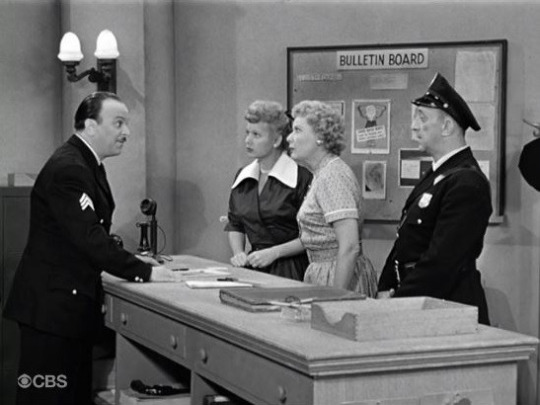
Frank Nelson also played a policeman named Nelson in “Ricky and Fred Are TV Fans” (ILL S2;E30) in 1953. In it, Lucy and Ethel are mistaken for Sticky Fingers Sal and Pickpocket Pearl. The dialogue is different, but also features rapid fire questions and answers between Ball and Nelson.
The telephone rings and it is announced that Myra Ponsenby has been found alive! She was in jail after speeding through a small town and arrested.
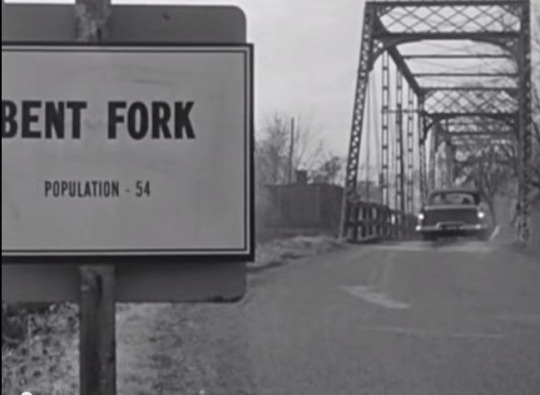
In “Tennessee Bound” (ILL S4;E15) new driver Lucy Ricardo also sped through a small town (Bent Fork) and was arrested!
After a moment, Liz suddenly realizes that that they assumed she murdered Myra! Liz laughs, knowing that she will now get the car fixed without any fuss!

In the usual bedtime tag, Liz is up late reading a murder mystery. George spoils the ending so he can get some sleep: the butler did it. George says the butler killed his wife because she talked too much when he was trying to go to sleep!
LIZ: “Ohhhh! Goodnight, George.”
#My Favorite Husband#Lucille Ball#Richard Denning#Bea Benadaret#Frank Nelson#Herb Vigran#radio#1948#CBS#Bob Lemond#I Love Lucy#Here's Lucy#Driving Test#Hudson Cars#Li'l Abner#Nash Automobiles#John Hiestand
4 notes
·
View notes